Activity Based Costing Applications
VerifiedAdded on 2020/02/18
|22
|4750
|36
AI Summary
This assignment explores the concept and application of Activity Based Costing (ABC). It examines how ABC is used in diverse sectors like healthcare and hospitality to accurately allocate costs and improve decision-making. The assignment also discusses the advantages and potential drawbacks of implementing ABC systems within organizations.
Contribute Materials
Your contribution can guide someone’s learning journey. Share your
documents today.
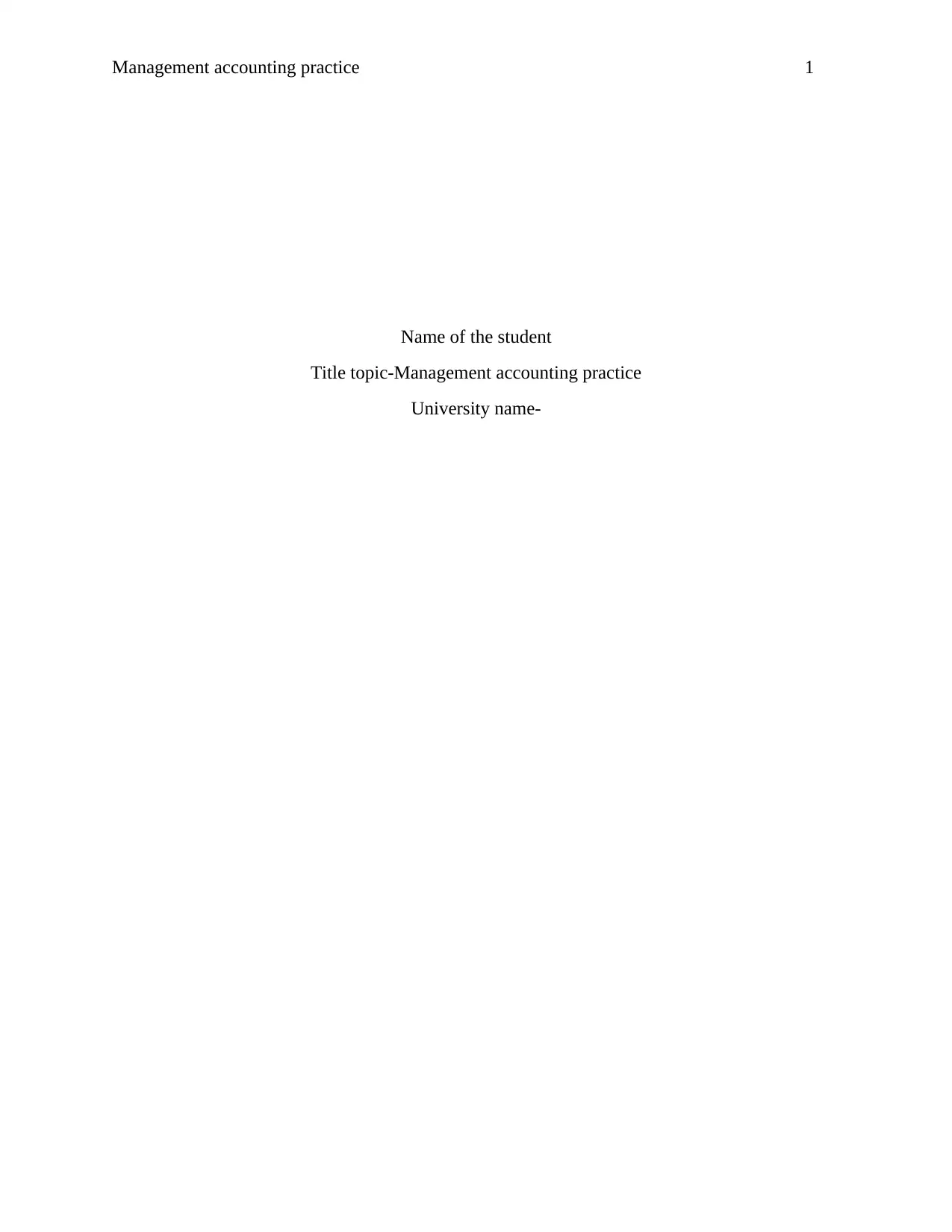
Management accounting practice 1
Name of the student
Title topic-Management accounting practice
University name-
Name of the student
Title topic-Management accounting practice
University name-
Secure Best Marks with AI Grader
Need help grading? Try our AI Grader for instant feedback on your assignments.
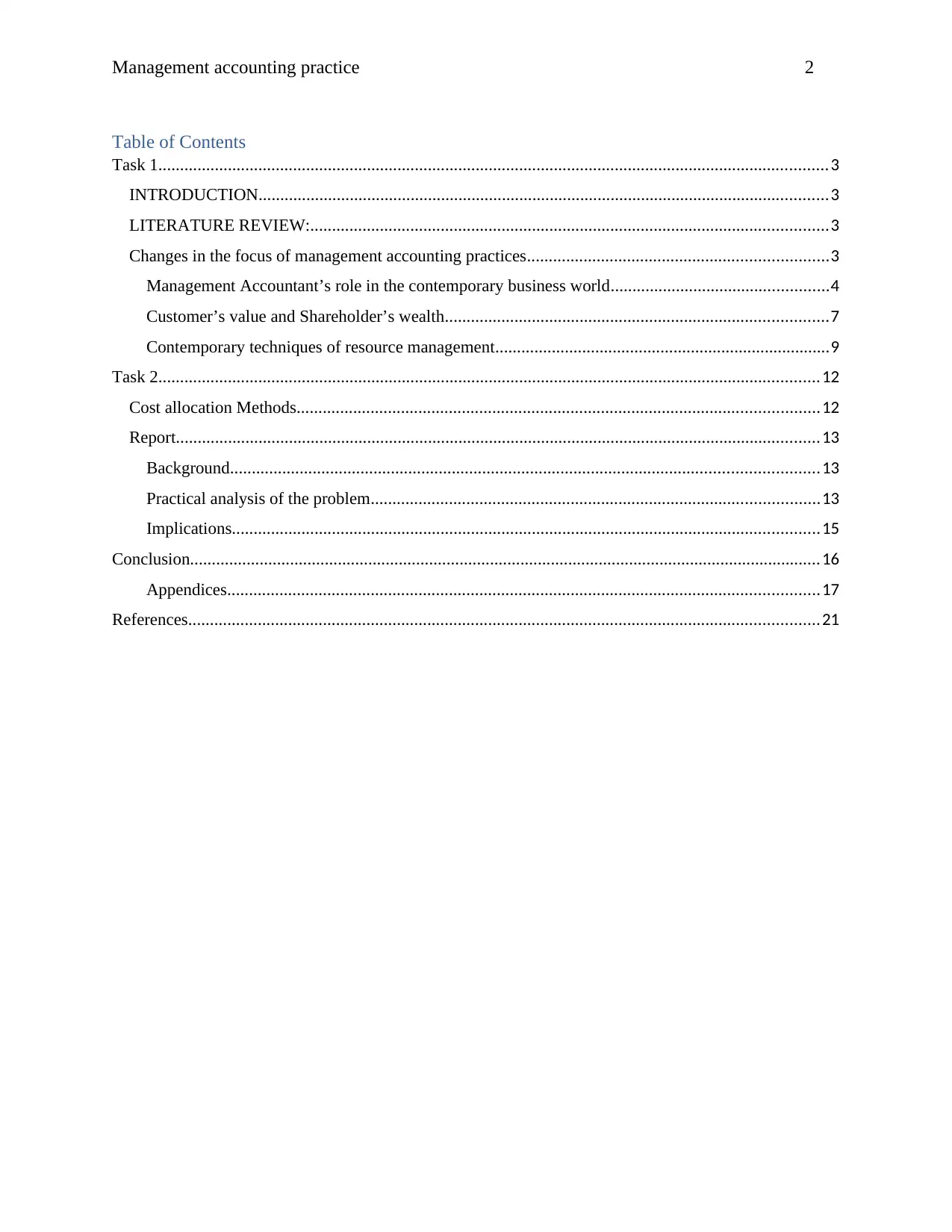
Management accounting practice 2
Table of Contents
Task 1..........................................................................................................................................................3
INTRODUCTION...................................................................................................................................3
LITERATURE REVIEW:.......................................................................................................................3
Changes in the focus of management accounting practices.....................................................................3
Management Accountant’s role in the contemporary business world..................................................4
Customer’s value and Shareholder’s wealth........................................................................................7
Contemporary techniques of resource management.............................................................................9
Task 2........................................................................................................................................................12
Cost allocation Methods........................................................................................................................12
Report....................................................................................................................................................13
Background.......................................................................................................................................13
Practical analysis of the problem.......................................................................................................13
Implications.......................................................................................................................................15
Conclusion.................................................................................................................................................16
Appendices........................................................................................................................................17
References.................................................................................................................................................21
Table of Contents
Task 1..........................................................................................................................................................3
INTRODUCTION...................................................................................................................................3
LITERATURE REVIEW:.......................................................................................................................3
Changes in the focus of management accounting practices.....................................................................3
Management Accountant’s role in the contemporary business world..................................................4
Customer’s value and Shareholder’s wealth........................................................................................7
Contemporary techniques of resource management.............................................................................9
Task 2........................................................................................................................................................12
Cost allocation Methods........................................................................................................................12
Report....................................................................................................................................................13
Background.......................................................................................................................................13
Practical analysis of the problem.......................................................................................................13
Implications.......................................................................................................................................15
Conclusion.................................................................................................................................................16
Appendices........................................................................................................................................17
References.................................................................................................................................................21
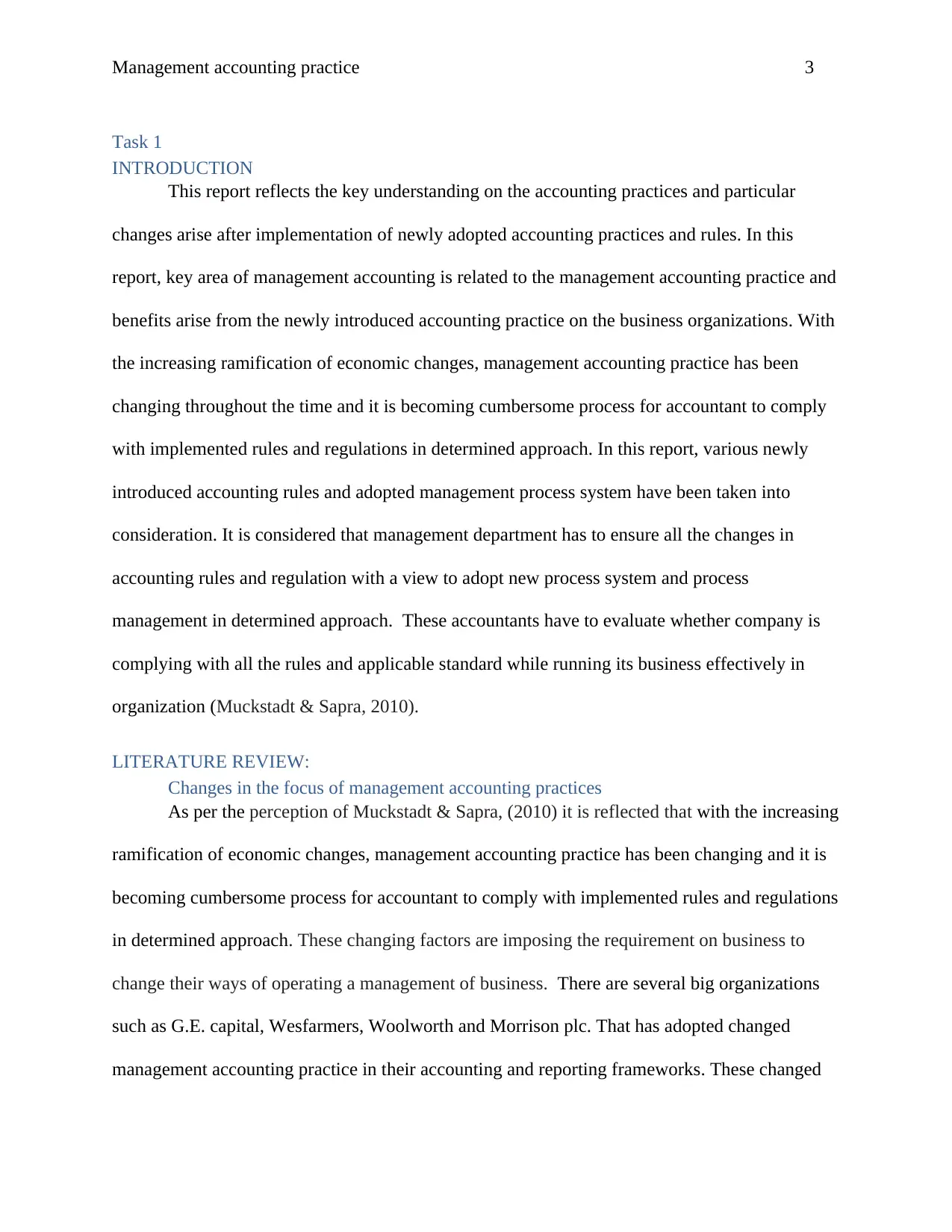
Management accounting practice 3
Task 1
INTRODUCTION
This report reflects the key understanding on the accounting practices and particular
changes arise after implementation of newly adopted accounting practices and rules. In this
report, key area of management accounting is related to the management accounting practice and
benefits arise from the newly introduced accounting practice on the business organizations. With
the increasing ramification of economic changes, management accounting practice has been
changing throughout the time and it is becoming cumbersome process for accountant to comply
with implemented rules and regulations in determined approach. In this report, various newly
introduced accounting rules and adopted management process system have been taken into
consideration. It is considered that management department has to ensure all the changes in
accounting rules and regulation with a view to adopt new process system and process
management in determined approach. These accountants have to evaluate whether company is
complying with all the rules and applicable standard while running its business effectively in
organization (Muckstadt & Sapra, 2010).
LITERATURE REVIEW:
Changes in the focus of management accounting practices
As per the perception of Muckstadt & Sapra, (2010) it is reflected that with the increasing
ramification of economic changes, management accounting practice has been changing and it is
becoming cumbersome process for accountant to comply with implemented rules and regulations
in determined approach. These changing factors are imposing the requirement on business to
change their ways of operating a management of business. There are several big organizations
such as G.E. capital, Wesfarmers, Woolworth and Morrison plc. That has adopted changed
management accounting practice in their accounting and reporting frameworks. These changed
Task 1
INTRODUCTION
This report reflects the key understanding on the accounting practices and particular
changes arise after implementation of newly adopted accounting practices and rules. In this
report, key area of management accounting is related to the management accounting practice and
benefits arise from the newly introduced accounting practice on the business organizations. With
the increasing ramification of economic changes, management accounting practice has been
changing throughout the time and it is becoming cumbersome process for accountant to comply
with implemented rules and regulations in determined approach. In this report, various newly
introduced accounting rules and adopted management process system have been taken into
consideration. It is considered that management department has to ensure all the changes in
accounting rules and regulation with a view to adopt new process system and process
management in determined approach. These accountants have to evaluate whether company is
complying with all the rules and applicable standard while running its business effectively in
organization (Muckstadt & Sapra, 2010).
LITERATURE REVIEW:
Changes in the focus of management accounting practices
As per the perception of Muckstadt & Sapra, (2010) it is reflected that with the increasing
ramification of economic changes, management accounting practice has been changing and it is
becoming cumbersome process for accountant to comply with implemented rules and regulations
in determined approach. These changing factors are imposing the requirement on business to
change their ways of operating a management of business. There are several big organizations
such as G.E. capital, Wesfarmers, Woolworth and Morrison plc. That has adopted changed
management accounting practice in their accounting and reporting frameworks. These changed
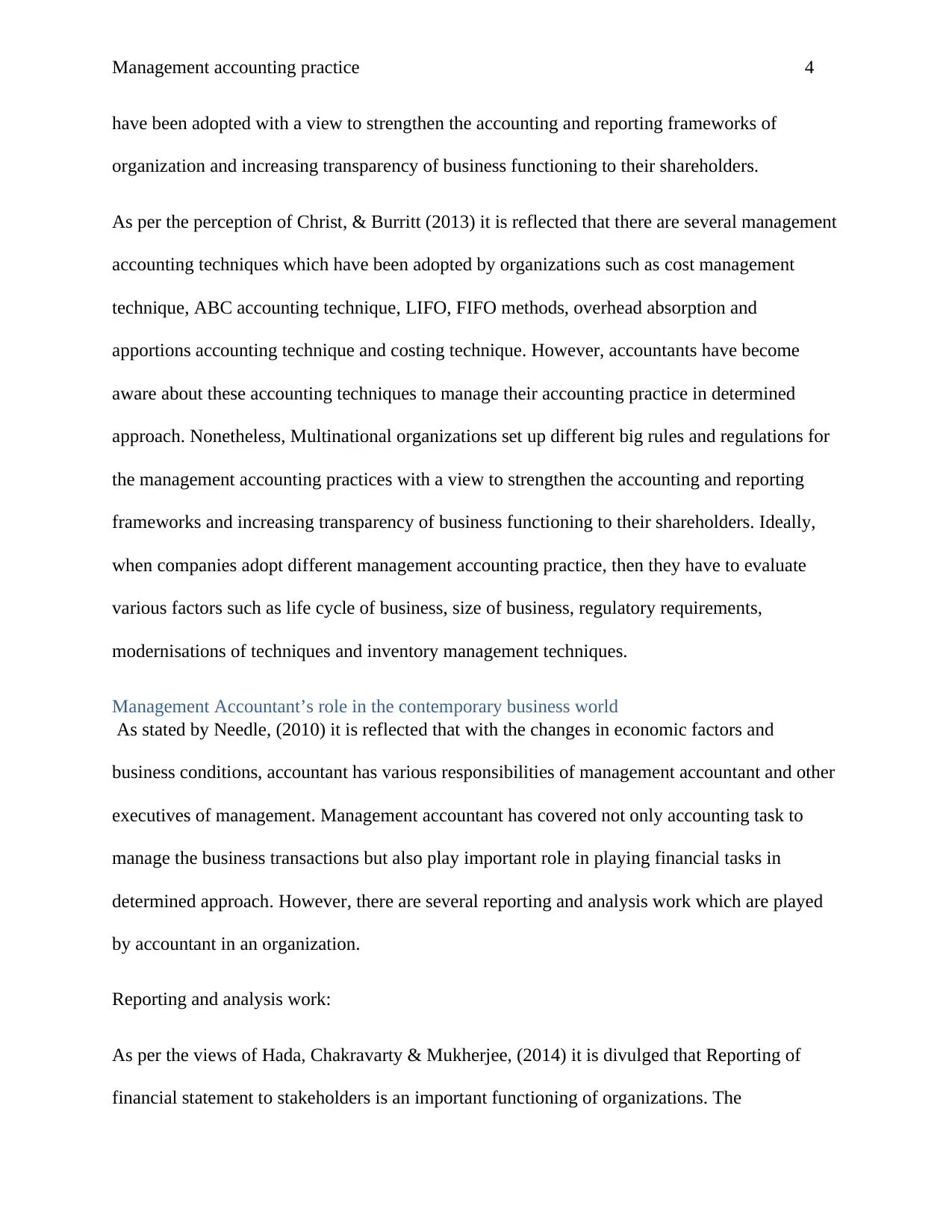
Management accounting practice 4
have been adopted with a view to strengthen the accounting and reporting frameworks of
organization and increasing transparency of business functioning to their shareholders.
As per the perception of Christ, & Burritt (2013) it is reflected that there are several management
accounting techniques which have been adopted by organizations such as cost management
technique, ABC accounting technique, LIFO, FIFO methods, overhead absorption and
apportions accounting technique and costing technique. However, accountants have become
aware about these accounting techniques to manage their accounting practice in determined
approach. Nonetheless, Multinational organizations set up different big rules and regulations for
the management accounting practices with a view to strengthen the accounting and reporting
frameworks and increasing transparency of business functioning to their shareholders. Ideally,
when companies adopt different management accounting practice, then they have to evaluate
various factors such as life cycle of business, size of business, regulatory requirements,
modernisations of techniques and inventory management techniques.
Management Accountant’s role in the contemporary business world
As stated by Needle, (2010) it is reflected that with the changes in economic factors and
business conditions, accountant has various responsibilities of management accountant and other
executives of management. Management accountant has covered not only accounting task to
manage the business transactions but also play important role in playing financial tasks in
determined approach. However, there are several reporting and analysis work which are played
by accountant in an organization.
Reporting and analysis work:
As per the views of Hada, Chakravarty & Mukherjee, (2014) it is divulged that Reporting of
financial statement to stakeholders is an important functioning of organizations. The
have been adopted with a view to strengthen the accounting and reporting frameworks of
organization and increasing transparency of business functioning to their shareholders.
As per the perception of Christ, & Burritt (2013) it is reflected that there are several management
accounting techniques which have been adopted by organizations such as cost management
technique, ABC accounting technique, LIFO, FIFO methods, overhead absorption and
apportions accounting technique and costing technique. However, accountants have become
aware about these accounting techniques to manage their accounting practice in determined
approach. Nonetheless, Multinational organizations set up different big rules and regulations for
the management accounting practices with a view to strengthen the accounting and reporting
frameworks and increasing transparency of business functioning to their shareholders. Ideally,
when companies adopt different management accounting practice, then they have to evaluate
various factors such as life cycle of business, size of business, regulatory requirements,
modernisations of techniques and inventory management techniques.
Management Accountant’s role in the contemporary business world
As stated by Needle, (2010) it is reflected that with the changes in economic factors and
business conditions, accountant has various responsibilities of management accountant and other
executives of management. Management accountant has covered not only accounting task to
manage the business transactions but also play important role in playing financial tasks in
determined approach. However, there are several reporting and analysis work which are played
by accountant in an organization.
Reporting and analysis work:
As per the views of Hada, Chakravarty & Mukherjee, (2014) it is divulged that Reporting of
financial statement to stakeholders is an important functioning of organizations. The
Secure Best Marks with AI Grader
Need help grading? Try our AI Grader for instant feedback on your assignments.
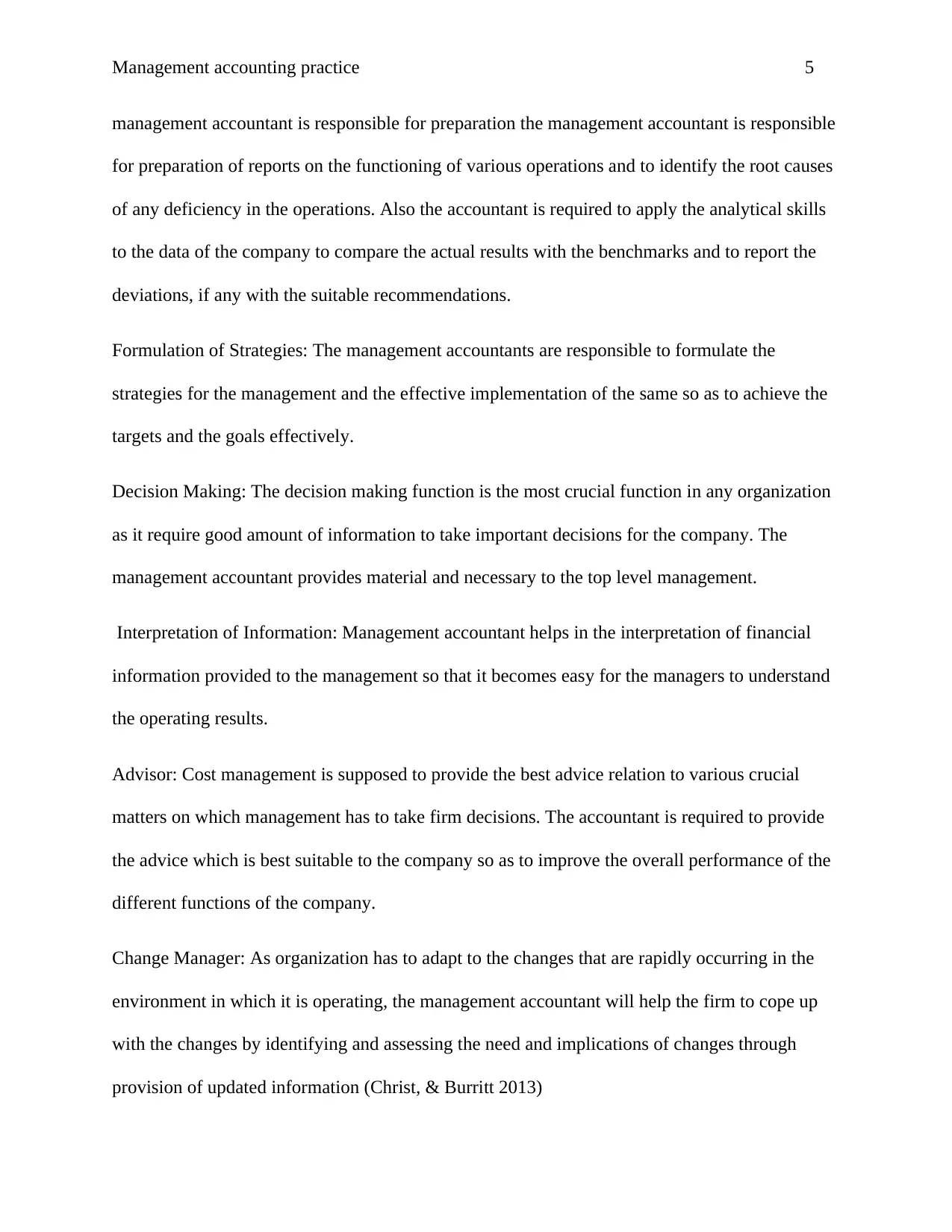
Management accounting practice 5
management accountant is responsible for preparation the management accountant is responsible
for preparation of reports on the functioning of various operations and to identify the root causes
of any deficiency in the operations. Also the accountant is required to apply the analytical skills
to the data of the company to compare the actual results with the benchmarks and to report the
deviations, if any with the suitable recommendations.
Formulation of Strategies: The management accountants are responsible to formulate the
strategies for the management and the effective implementation of the same so as to achieve the
targets and the goals effectively.
Decision Making: The decision making function is the most crucial function in any organization
as it require good amount of information to take important decisions for the company. The
management accountant provides material and necessary to the top level management.
Interpretation of Information: Management accountant helps in the interpretation of financial
information provided to the management so that it becomes easy for the managers to understand
the operating results.
Advisor: Cost management is supposed to provide the best advice relation to various crucial
matters on which management has to take firm decisions. The accountant is required to provide
the advice which is best suitable to the company so as to improve the overall performance of the
different functions of the company.
Change Manager: As organization has to adapt to the changes that are rapidly occurring in the
environment in which it is operating, the management accountant will help the firm to cope up
with the changes by identifying and assessing the need and implications of changes through
provision of updated information (Christ, & Burritt 2013)
management accountant is responsible for preparation the management accountant is responsible
for preparation of reports on the functioning of various operations and to identify the root causes
of any deficiency in the operations. Also the accountant is required to apply the analytical skills
to the data of the company to compare the actual results with the benchmarks and to report the
deviations, if any with the suitable recommendations.
Formulation of Strategies: The management accountants are responsible to formulate the
strategies for the management and the effective implementation of the same so as to achieve the
targets and the goals effectively.
Decision Making: The decision making function is the most crucial function in any organization
as it require good amount of information to take important decisions for the company. The
management accountant provides material and necessary to the top level management.
Interpretation of Information: Management accountant helps in the interpretation of financial
information provided to the management so that it becomes easy for the managers to understand
the operating results.
Advisor: Cost management is supposed to provide the best advice relation to various crucial
matters on which management has to take firm decisions. The accountant is required to provide
the advice which is best suitable to the company so as to improve the overall performance of the
different functions of the company.
Change Manager: As organization has to adapt to the changes that are rapidly occurring in the
environment in which it is operating, the management accountant will help the firm to cope up
with the changes by identifying and assessing the need and implications of changes through
provision of updated information (Christ, & Burritt 2013)
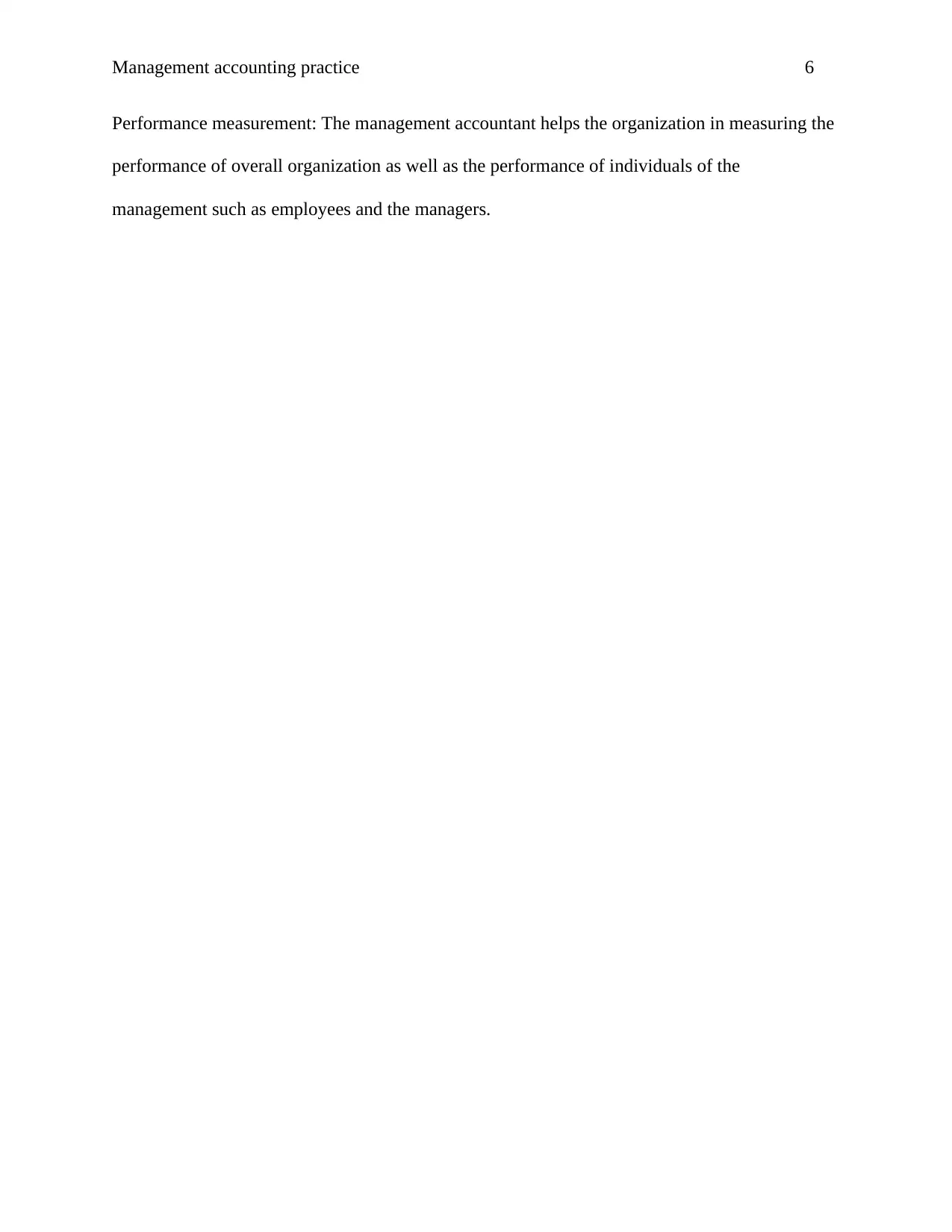
Management accounting practice 6
Performance measurement: The management accountant helps the organization in measuring the
performance of overall organization as well as the performance of individuals of the
management such as employees and the managers.
Performance measurement: The management accountant helps the organization in measuring the
performance of overall organization as well as the performance of individuals of the
management such as employees and the managers.
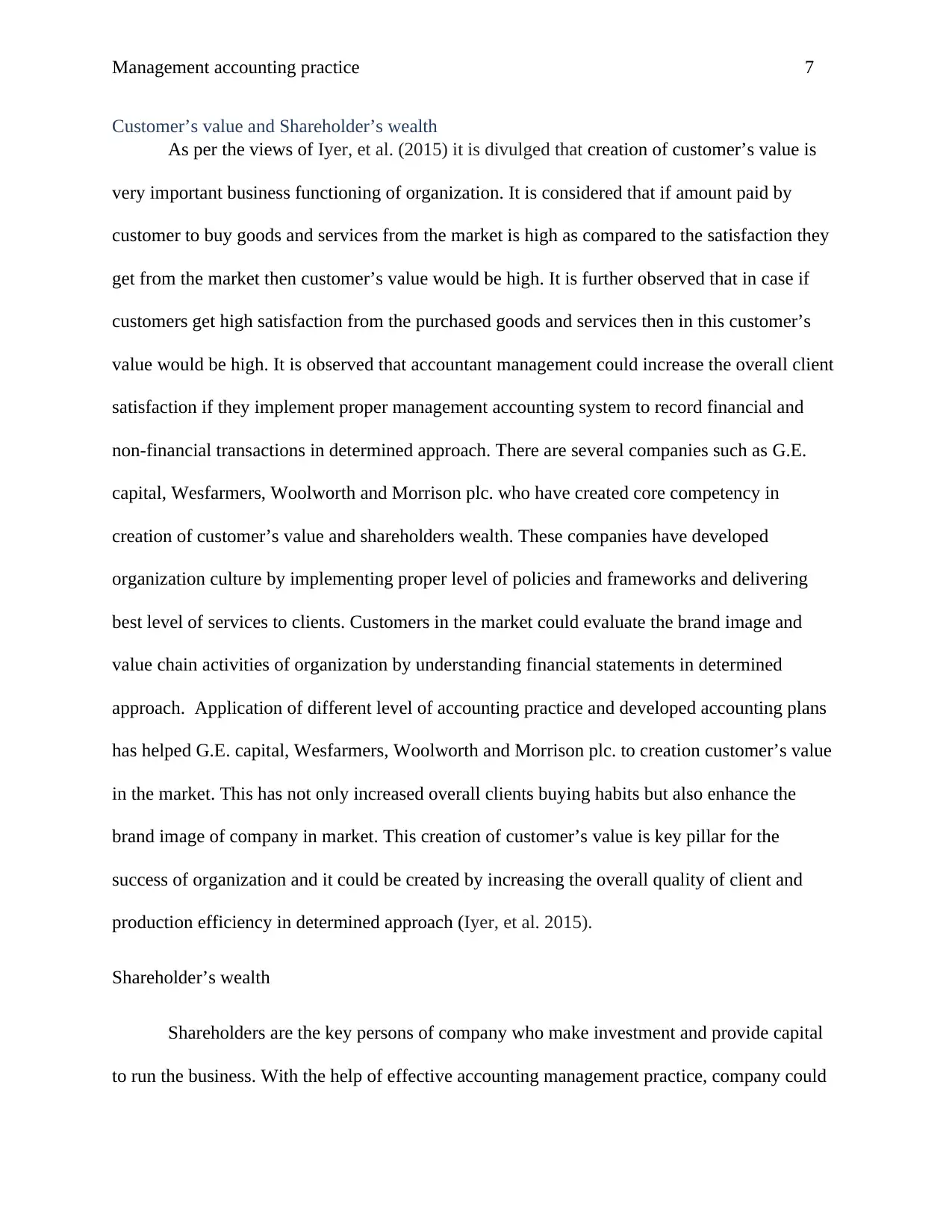
Management accounting practice 7
Customer’s value and Shareholder’s wealth
As per the views of Iyer, et al. (2015) it is divulged that creation of customer’s value is
very important business functioning of organization. It is considered that if amount paid by
customer to buy goods and services from the market is high as compared to the satisfaction they
get from the market then customer’s value would be high. It is further observed that in case if
customers get high satisfaction from the purchased goods and services then in this customer’s
value would be high. It is observed that accountant management could increase the overall client
satisfaction if they implement proper management accounting system to record financial and
non-financial transactions in determined approach. There are several companies such as G.E.
capital, Wesfarmers, Woolworth and Morrison plc. who have created core competency in
creation of customer’s value and shareholders wealth. These companies have developed
organization culture by implementing proper level of policies and frameworks and delivering
best level of services to clients. Customers in the market could evaluate the brand image and
value chain activities of organization by understanding financial statements in determined
approach. Application of different level of accounting practice and developed accounting plans
has helped G.E. capital, Wesfarmers, Woolworth and Morrison plc. to creation customer’s value
in the market. This has not only increased overall clients buying habits but also enhance the
brand image of company in market. This creation of customer’s value is key pillar for the
success of organization and it could be created by increasing the overall quality of client and
production efficiency in determined approach (Iyer, et al. 2015).
Shareholder’s wealth
Shareholders are the key persons of company who make investment and provide capital
to run the business. With the help of effective accounting management practice, company could
Customer’s value and Shareholder’s wealth
As per the views of Iyer, et al. (2015) it is divulged that creation of customer’s value is
very important business functioning of organization. It is considered that if amount paid by
customer to buy goods and services from the market is high as compared to the satisfaction they
get from the market then customer’s value would be high. It is further observed that in case if
customers get high satisfaction from the purchased goods and services then in this customer’s
value would be high. It is observed that accountant management could increase the overall client
satisfaction if they implement proper management accounting system to record financial and
non-financial transactions in determined approach. There are several companies such as G.E.
capital, Wesfarmers, Woolworth and Morrison plc. who have created core competency in
creation of customer’s value and shareholders wealth. These companies have developed
organization culture by implementing proper level of policies and frameworks and delivering
best level of services to clients. Customers in the market could evaluate the brand image and
value chain activities of organization by understanding financial statements in determined
approach. Application of different level of accounting practice and developed accounting plans
has helped G.E. capital, Wesfarmers, Woolworth and Morrison plc. to creation customer’s value
in the market. This has not only increased overall clients buying habits but also enhance the
brand image of company in market. This creation of customer’s value is key pillar for the
success of organization and it could be created by increasing the overall quality of client and
production efficiency in determined approach (Iyer, et al. 2015).
Shareholder’s wealth
Shareholders are the key persons of company who make investment and provide capital
to run the business. With the help of effective accounting management practice, company could
Paraphrase This Document
Need a fresh take? Get an instant paraphrase of this document with our AI Paraphraser
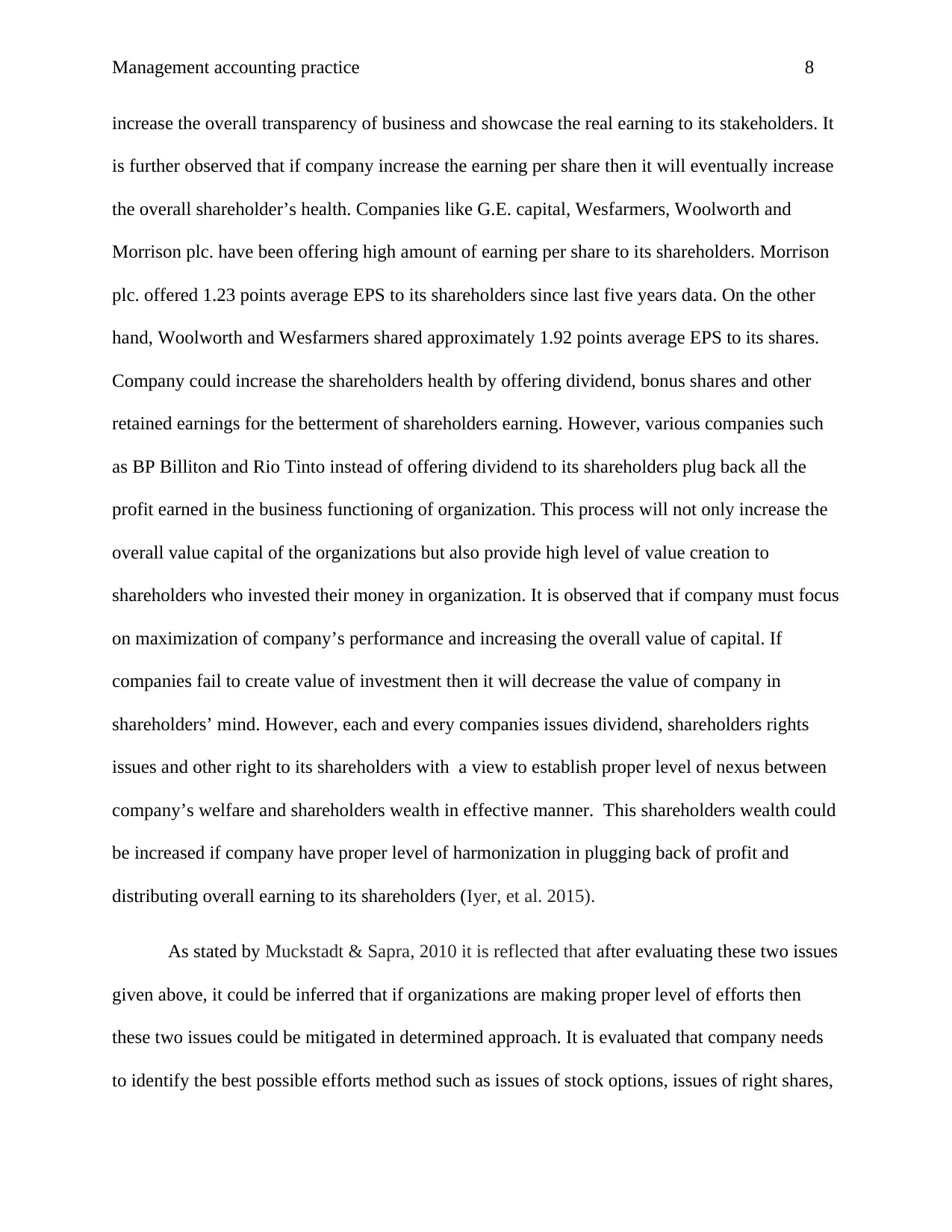
Management accounting practice 8
increase the overall transparency of business and showcase the real earning to its stakeholders. It
is further observed that if company increase the earning per share then it will eventually increase
the overall shareholder’s health. Companies like G.E. capital, Wesfarmers, Woolworth and
Morrison plc. have been offering high amount of earning per share to its shareholders. Morrison
plc. offered 1.23 points average EPS to its shareholders since last five years data. On the other
hand, Woolworth and Wesfarmers shared approximately 1.92 points average EPS to its shares.
Company could increase the shareholders health by offering dividend, bonus shares and other
retained earnings for the betterment of shareholders earning. However, various companies such
as BP Billiton and Rio Tinto instead of offering dividend to its shareholders plug back all the
profit earned in the business functioning of organization. This process will not only increase the
overall value capital of the organizations but also provide high level of value creation to
shareholders who invested their money in organization. It is observed that if company must focus
on maximization of company’s performance and increasing the overall value of capital. If
companies fail to create value of investment then it will decrease the value of company in
shareholders’ mind. However, each and every companies issues dividend, shareholders rights
issues and other right to its shareholders with a view to establish proper level of nexus between
company’s welfare and shareholders wealth in effective manner. This shareholders wealth could
be increased if company have proper level of harmonization in plugging back of profit and
distributing overall earning to its shareholders (Iyer, et al. 2015).
As stated by Muckstadt & Sapra, 2010 it is reflected that after evaluating these two issues
given above, it could be inferred that if organizations are making proper level of efforts then
these two issues could be mitigated in determined approach. It is evaluated that company needs
to identify the best possible efforts method such as issues of stock options, issues of right shares,
increase the overall transparency of business and showcase the real earning to its stakeholders. It
is further observed that if company increase the earning per share then it will eventually increase
the overall shareholder’s health. Companies like G.E. capital, Wesfarmers, Woolworth and
Morrison plc. have been offering high amount of earning per share to its shareholders. Morrison
plc. offered 1.23 points average EPS to its shareholders since last five years data. On the other
hand, Woolworth and Wesfarmers shared approximately 1.92 points average EPS to its shares.
Company could increase the shareholders health by offering dividend, bonus shares and other
retained earnings for the betterment of shareholders earning. However, various companies such
as BP Billiton and Rio Tinto instead of offering dividend to its shareholders plug back all the
profit earned in the business functioning of organization. This process will not only increase the
overall value capital of the organizations but also provide high level of value creation to
shareholders who invested their money in organization. It is observed that if company must focus
on maximization of company’s performance and increasing the overall value of capital. If
companies fail to create value of investment then it will decrease the value of company in
shareholders’ mind. However, each and every companies issues dividend, shareholders rights
issues and other right to its shareholders with a view to establish proper level of nexus between
company’s welfare and shareholders wealth in effective manner. This shareholders wealth could
be increased if company have proper level of harmonization in plugging back of profit and
distributing overall earning to its shareholders (Iyer, et al. 2015).
As stated by Muckstadt & Sapra, 2010 it is reflected that after evaluating these two issues
given above, it could be inferred that if organizations are making proper level of efforts then
these two issues could be mitigated in determined approach. It is evaluated that company needs
to identify the best possible efforts method such as issues of stock options, issues of right shares,
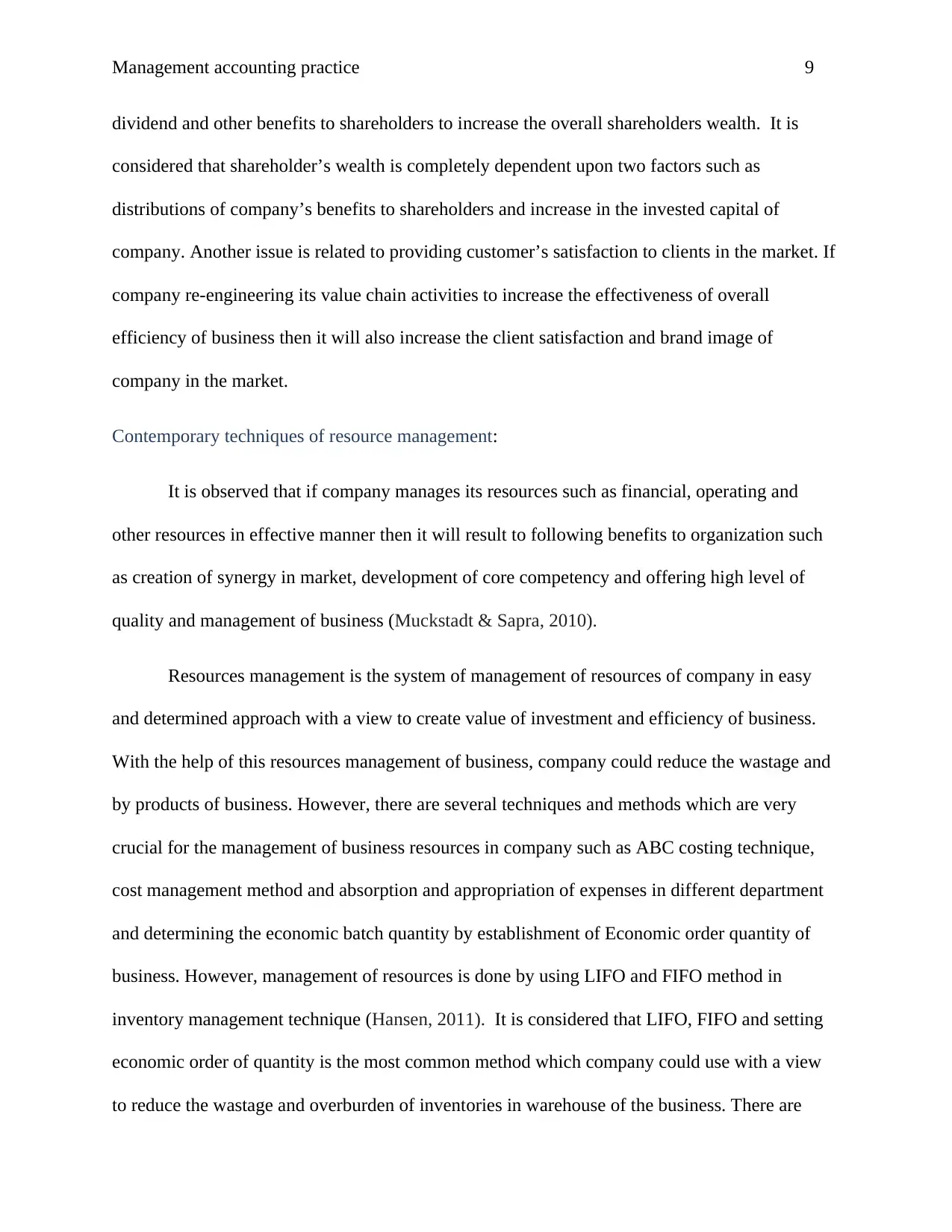
Management accounting practice 9
dividend and other benefits to shareholders to increase the overall shareholders wealth. It is
considered that shareholder’s wealth is completely dependent upon two factors such as
distributions of company’s benefits to shareholders and increase in the invested capital of
company. Another issue is related to providing customer’s satisfaction to clients in the market. If
company re-engineering its value chain activities to increase the effectiveness of overall
efficiency of business then it will also increase the client satisfaction and brand image of
company in the market.
Contemporary techniques of resource management:
It is observed that if company manages its resources such as financial, operating and
other resources in effective manner then it will result to following benefits to organization such
as creation of synergy in market, development of core competency and offering high level of
quality and management of business (Muckstadt & Sapra, 2010).
Resources management is the system of management of resources of company in easy
and determined approach with a view to create value of investment and efficiency of business.
With the help of this resources management of business, company could reduce the wastage and
by products of business. However, there are several techniques and methods which are very
crucial for the management of business resources in company such as ABC costing technique,
cost management method and absorption and appropriation of expenses in different department
and determining the economic batch quantity by establishment of Economic order quantity of
business. However, management of resources is done by using LIFO and FIFO method in
inventory management technique (Hansen, 2011). It is considered that LIFO, FIFO and setting
economic order of quantity is the most common method which company could use with a view
to reduce the wastage and overburden of inventories in warehouse of the business. There are
dividend and other benefits to shareholders to increase the overall shareholders wealth. It is
considered that shareholder’s wealth is completely dependent upon two factors such as
distributions of company’s benefits to shareholders and increase in the invested capital of
company. Another issue is related to providing customer’s satisfaction to clients in the market. If
company re-engineering its value chain activities to increase the effectiveness of overall
efficiency of business then it will also increase the client satisfaction and brand image of
company in the market.
Contemporary techniques of resource management:
It is observed that if company manages its resources such as financial, operating and
other resources in effective manner then it will result to following benefits to organization such
as creation of synergy in market, development of core competency and offering high level of
quality and management of business (Muckstadt & Sapra, 2010).
Resources management is the system of management of resources of company in easy
and determined approach with a view to create value of investment and efficiency of business.
With the help of this resources management of business, company could reduce the wastage and
by products of business. However, there are several techniques and methods which are very
crucial for the management of business resources in company such as ABC costing technique,
cost management method and absorption and appropriation of expenses in different department
and determining the economic batch quantity by establishment of Economic order quantity of
business. However, management of resources is done by using LIFO and FIFO method in
inventory management technique (Hansen, 2011). It is considered that LIFO, FIFO and setting
economic order of quantity is the most common method which company could use with a view
to reduce the wastage and overburden of inventories in warehouse of the business. There are
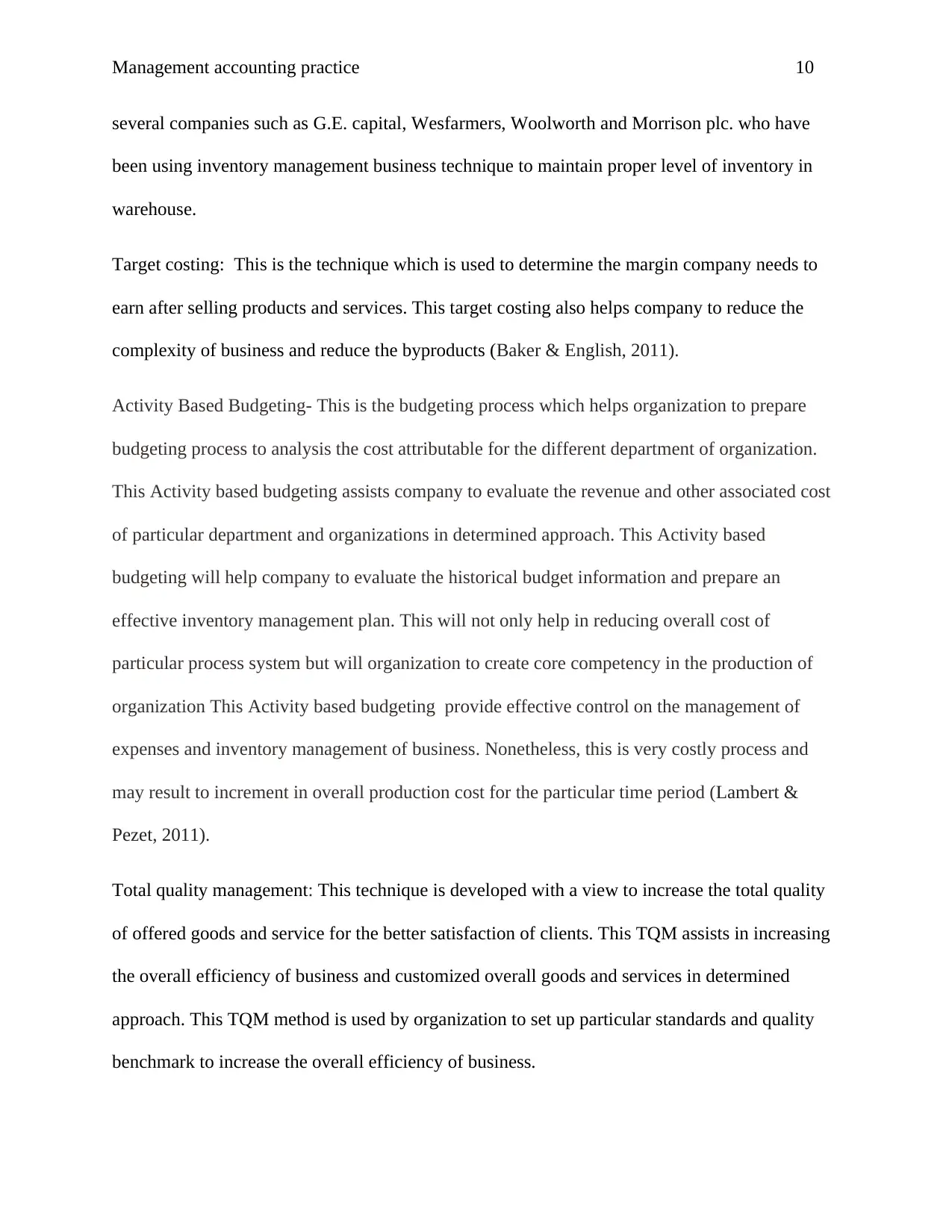
Management accounting practice 10
several companies such as G.E. capital, Wesfarmers, Woolworth and Morrison plc. who have
been using inventory management business technique to maintain proper level of inventory in
warehouse.
Target costing: This is the technique which is used to determine the margin company needs to
earn after selling products and services. This target costing also helps company to reduce the
complexity of business and reduce the byproducts (Baker & English, 2011).
Activity Based Budgeting- This is the budgeting process which helps organization to prepare
budgeting process to analysis the cost attributable for the different department of organization.
This Activity based budgeting assists company to evaluate the revenue and other associated cost
of particular department and organizations in determined approach. This Activity based
budgeting will help company to evaluate the historical budget information and prepare an
effective inventory management plan. This will not only help in reducing overall cost of
particular process system but will organization to create core competency in the production of
organization This Activity based budgeting provide effective control on the management of
expenses and inventory management of business. Nonetheless, this is very costly process and
may result to increment in overall production cost for the particular time period (Lambert &
Pezet, 2011).
Total quality management: This technique is developed with a view to increase the total quality
of offered goods and service for the better satisfaction of clients. This TQM assists in increasing
the overall efficiency of business and customized overall goods and services in determined
approach. This TQM method is used by organization to set up particular standards and quality
benchmark to increase the overall efficiency of business.
several companies such as G.E. capital, Wesfarmers, Woolworth and Morrison plc. who have
been using inventory management business technique to maintain proper level of inventory in
warehouse.
Target costing: This is the technique which is used to determine the margin company needs to
earn after selling products and services. This target costing also helps company to reduce the
complexity of business and reduce the byproducts (Baker & English, 2011).
Activity Based Budgeting- This is the budgeting process which helps organization to prepare
budgeting process to analysis the cost attributable for the different department of organization.
This Activity based budgeting assists company to evaluate the revenue and other associated cost
of particular department and organizations in determined approach. This Activity based
budgeting will help company to evaluate the historical budget information and prepare an
effective inventory management plan. This will not only help in reducing overall cost of
particular process system but will organization to create core competency in the production of
organization This Activity based budgeting provide effective control on the management of
expenses and inventory management of business. Nonetheless, this is very costly process and
may result to increment in overall production cost for the particular time period (Lambert &
Pezet, 2011).
Total quality management: This technique is developed with a view to increase the total quality
of offered goods and service for the better satisfaction of clients. This TQM assists in increasing
the overall efficiency of business and customized overall goods and services in determined
approach. This TQM method is used by organization to set up particular standards and quality
benchmark to increase the overall efficiency of business.
Secure Best Marks with AI Grader
Need help grading? Try our AI Grader for instant feedback on your assignments.
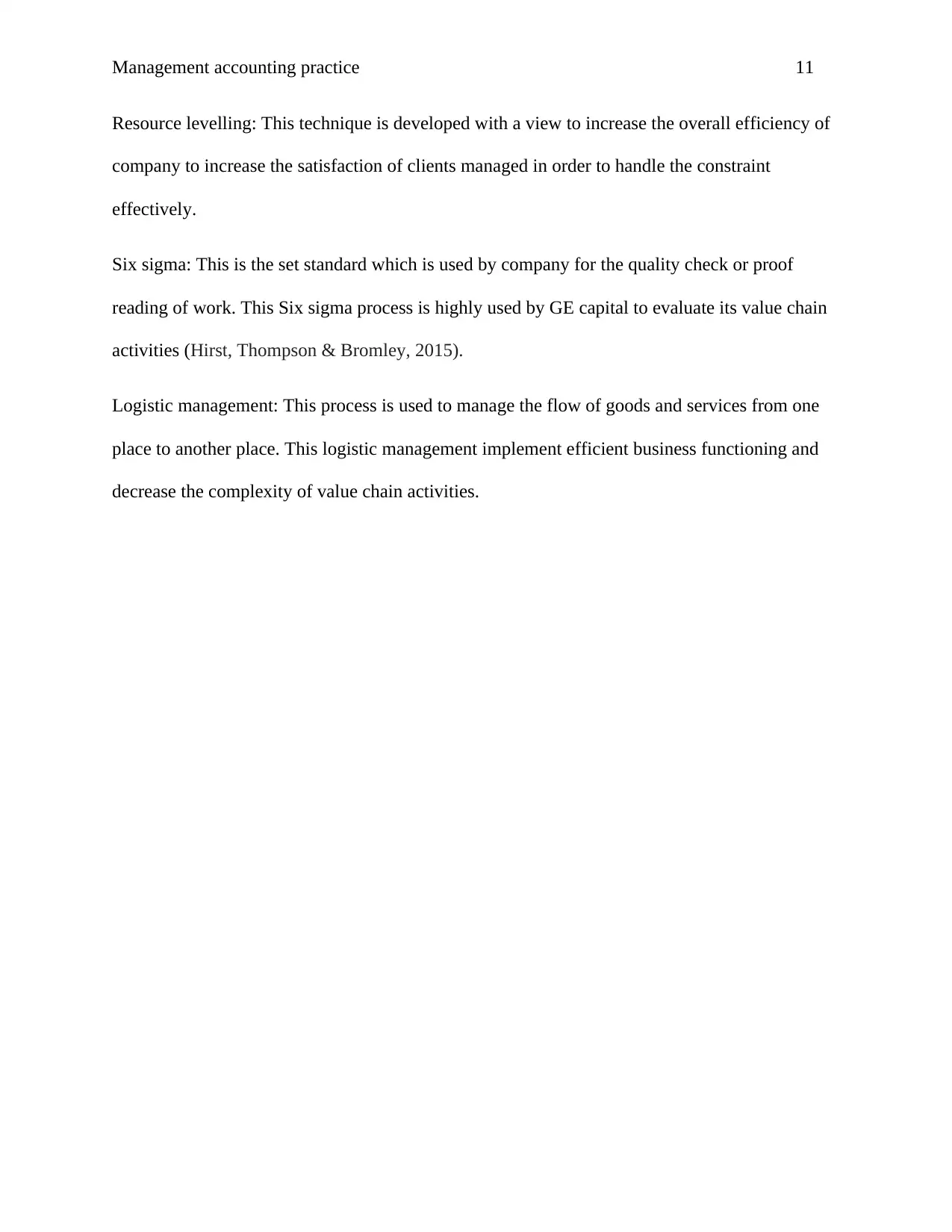
Management accounting practice 11
Resource levelling: This technique is developed with a view to increase the overall efficiency of
company to increase the satisfaction of clients managed in order to handle the constraint
effectively.
Six sigma: This is the set standard which is used by company for the quality check or proof
reading of work. This Six sigma process is highly used by GE capital to evaluate its value chain
activities (Hirst, Thompson & Bromley, 2015).
Logistic management: This process is used to manage the flow of goods and services from one
place to another place. This logistic management implement efficient business functioning and
decrease the complexity of value chain activities.
Resource levelling: This technique is developed with a view to increase the overall efficiency of
company to increase the satisfaction of clients managed in order to handle the constraint
effectively.
Six sigma: This is the set standard which is used by company for the quality check or proof
reading of work. This Six sigma process is highly used by GE capital to evaluate its value chain
activities (Hirst, Thompson & Bromley, 2015).
Logistic management: This process is used to manage the flow of goods and services from one
place to another place. This logistic management implement efficient business functioning and
decrease the complexity of value chain activities.
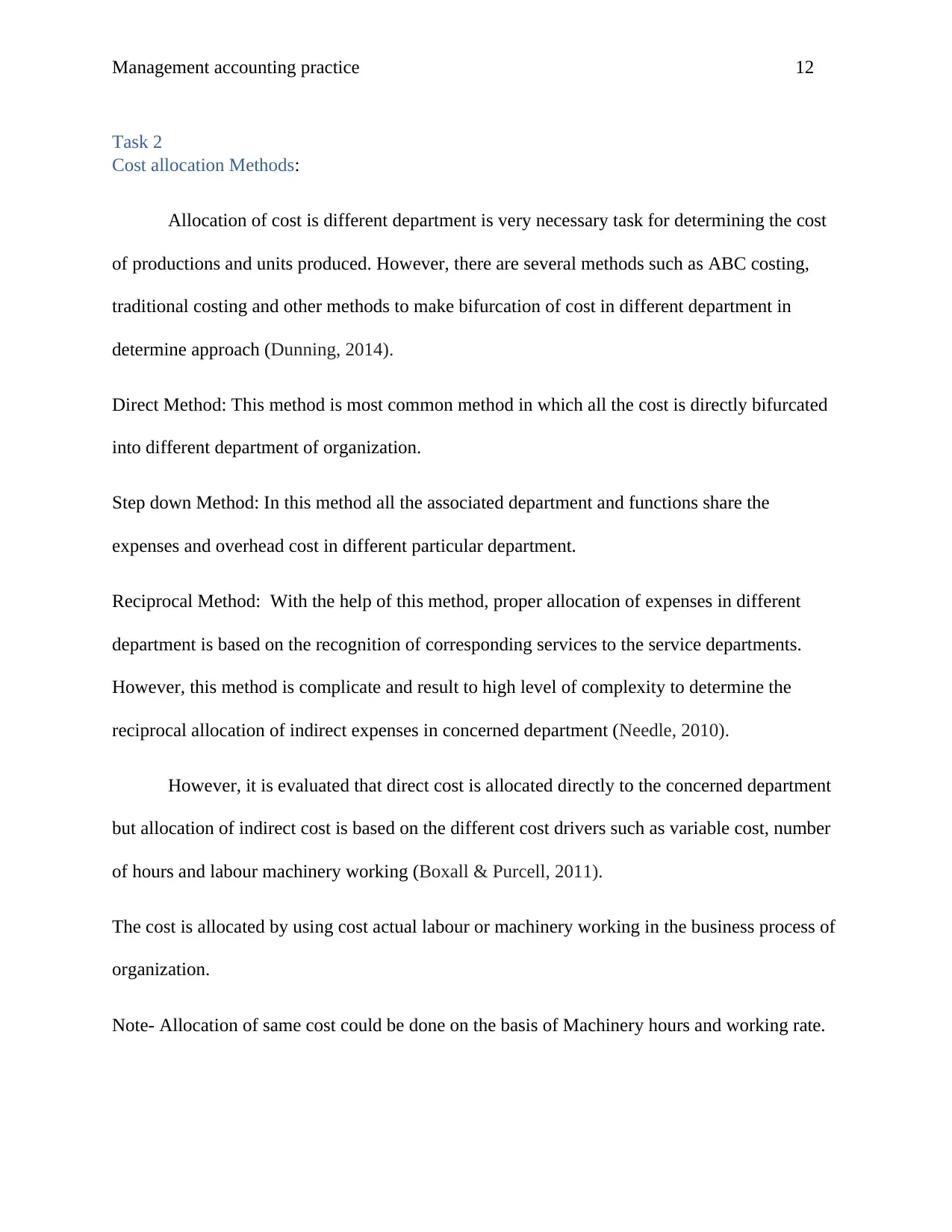
Management accounting practice 12
Task 2
Cost allocation Methods:
Allocation of cost is different department is very necessary task for determining the cost
of productions and units produced. However, there are several methods such as ABC costing,
traditional costing and other methods to make bifurcation of cost in different department in
determine approach (Dunning, 2014).
Direct Method: This method is most common method in which all the cost is directly bifurcated
into different department of organization.
Step down Method: In this method all the associated department and functions share the
expenses and overhead cost in different particular department.
Reciprocal Method: With the help of this method, proper allocation of expenses in different
department is based on the recognition of corresponding services to the service departments.
However, this method is complicate and result to high level of complexity to determine the
reciprocal allocation of indirect expenses in concerned department (Needle, 2010).
However, it is evaluated that direct cost is allocated directly to the concerned department
but allocation of indirect cost is based on the different cost drivers such as variable cost, number
of hours and labour machinery working (Boxall & Purcell, 2011).
The cost is allocated by using cost actual labour or machinery working in the business process of
organization.
Note- Allocation of same cost could be done on the basis of Machinery hours and working rate.
Task 2
Cost allocation Methods:
Allocation of cost is different department is very necessary task for determining the cost
of productions and units produced. However, there are several methods such as ABC costing,
traditional costing and other methods to make bifurcation of cost in different department in
determine approach (Dunning, 2014).
Direct Method: This method is most common method in which all the cost is directly bifurcated
into different department of organization.
Step down Method: In this method all the associated department and functions share the
expenses and overhead cost in different particular department.
Reciprocal Method: With the help of this method, proper allocation of expenses in different
department is based on the recognition of corresponding services to the service departments.
However, this method is complicate and result to high level of complexity to determine the
reciprocal allocation of indirect expenses in concerned department (Needle, 2010).
However, it is evaluated that direct cost is allocated directly to the concerned department
but allocation of indirect cost is based on the different cost drivers such as variable cost, number
of hours and labour machinery working (Boxall & Purcell, 2011).
The cost is allocated by using cost actual labour or machinery working in the business process of
organization.
Note- Allocation of same cost could be done on the basis of Machinery hours and working rate.
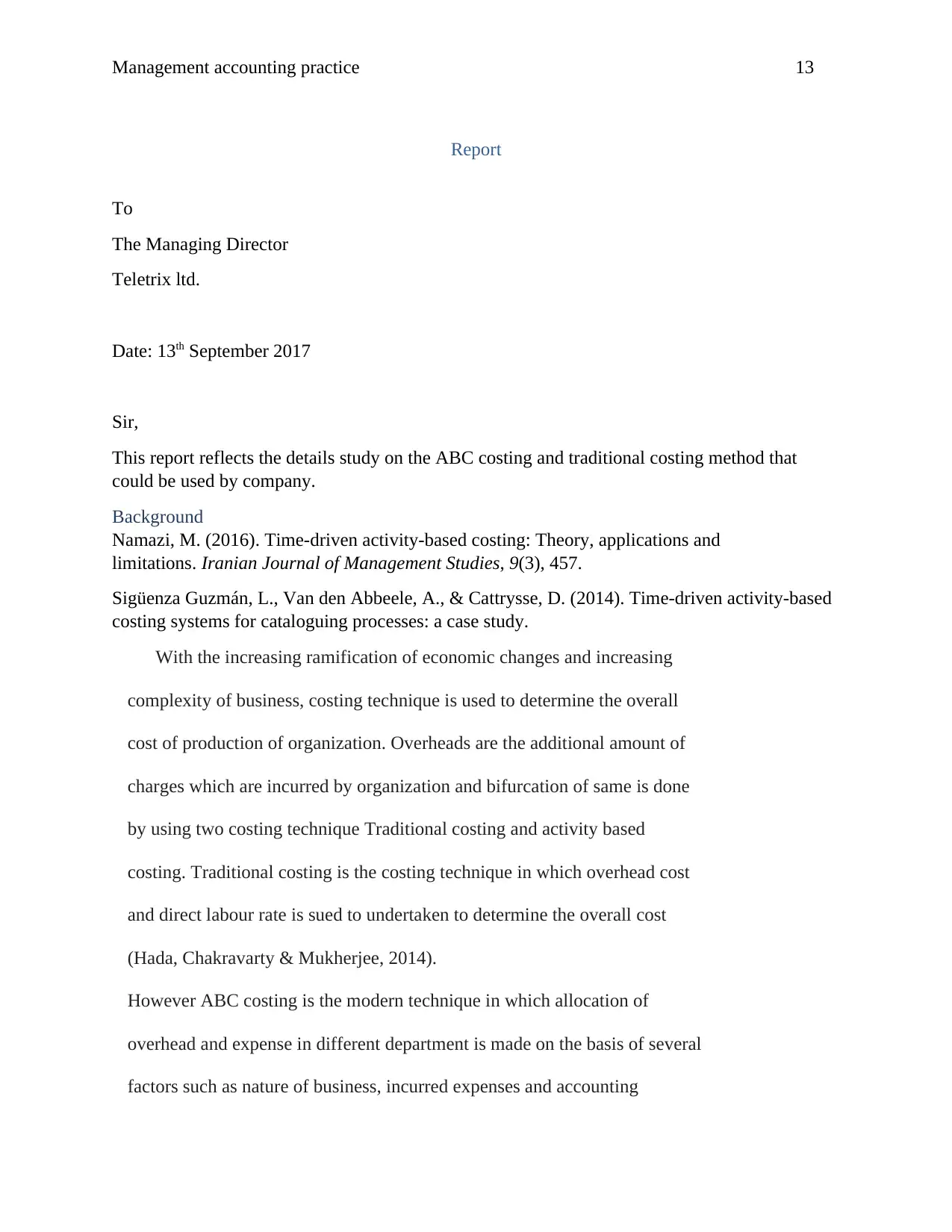
Management accounting practice 13
Report
To
The Managing Director
Teletrix ltd.
Date: 13th September 2017
Sir,
This report reflects the details study on the ABC costing and traditional costing method that
could be used by company.
Background
Namazi, M. (2016). Time-driven activity-based costing: Theory, applications and
limitations. Iranian Journal of Management Studies, 9(3), 457.
Sigüenza Guzmán, L., Van den Abbeele, A., & Cattrysse, D. (2014). Time-driven activity-based
costing systems for cataloguing processes: a case study.
With the increasing ramification of economic changes and increasing
complexity of business, costing technique is used to determine the overall
cost of production of organization. Overheads are the additional amount of
charges which are incurred by organization and bifurcation of same is done
by using two costing technique Traditional costing and activity based
costing. Traditional costing is the costing technique in which overhead cost
and direct labour rate is sued to undertaken to determine the overall cost
(Hada, Chakravarty & Mukherjee, 2014).
However ABC costing is the modern technique in which allocation of
overhead and expense in different department is made on the basis of several
factors such as nature of business, incurred expenses and accounting
Report
To
The Managing Director
Teletrix ltd.
Date: 13th September 2017
Sir,
This report reflects the details study on the ABC costing and traditional costing method that
could be used by company.
Background
Namazi, M. (2016). Time-driven activity-based costing: Theory, applications and
limitations. Iranian Journal of Management Studies, 9(3), 457.
Sigüenza Guzmán, L., Van den Abbeele, A., & Cattrysse, D. (2014). Time-driven activity-based
costing systems for cataloguing processes: a case study.
With the increasing ramification of economic changes and increasing
complexity of business, costing technique is used to determine the overall
cost of production of organization. Overheads are the additional amount of
charges which are incurred by organization and bifurcation of same is done
by using two costing technique Traditional costing and activity based
costing. Traditional costing is the costing technique in which overhead cost
and direct labour rate is sued to undertaken to determine the overall cost
(Hada, Chakravarty & Mukherjee, 2014).
However ABC costing is the modern technique in which allocation of
overhead and expense in different department is made on the basis of several
factors such as nature of business, incurred expenses and accounting
Paraphrase This Document
Need a fresh take? Get an instant paraphrase of this document with our AI Paraphraser
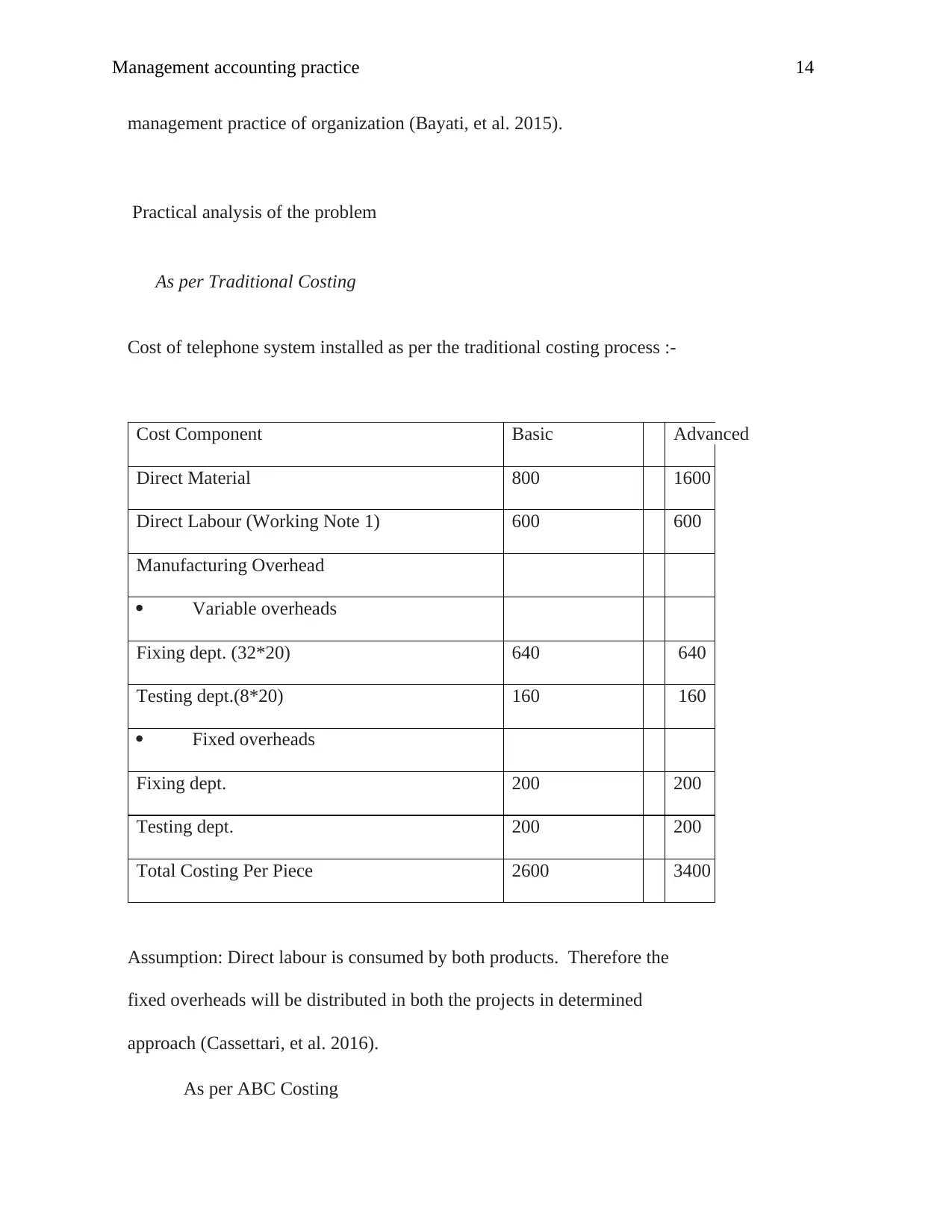
Management accounting practice 14
management practice of organization (Bayati, et al. 2015).
Practical analysis of the problem
As per Traditional Costing
Cost of telephone system installed as per the traditional costing process :-
Cost Component Basic Advanced
Direct Material 800 1600
Direct Labour (Working Note 1) 600 600
Manufacturing Overhead
Variable overheads
Fixing dept. (32*20) 640 640
Testing dept.(8*20) 160 160
Fixed overheads
Fixing dept. 200 200
Testing dept. 200 200
Total Costing Per Piece 2600 3400
Assumption: Direct labour is consumed by both products. Therefore the
fixed overheads will be distributed in both the projects in determined
approach (Cassettari, et al. 2016).
As per ABC Costing
management practice of organization (Bayati, et al. 2015).
Practical analysis of the problem
As per Traditional Costing
Cost of telephone system installed as per the traditional costing process :-
Cost Component Basic Advanced
Direct Material 800 1600
Direct Labour (Working Note 1) 600 600
Manufacturing Overhead
Variable overheads
Fixing dept. (32*20) 640 640
Testing dept.(8*20) 160 160
Fixed overheads
Fixing dept. 200 200
Testing dept. 200 200
Total Costing Per Piece 2600 3400
Assumption: Direct labour is consumed by both products. Therefore the
fixed overheads will be distributed in both the projects in determined
approach (Cassettari, et al. 2016).
As per ABC Costing
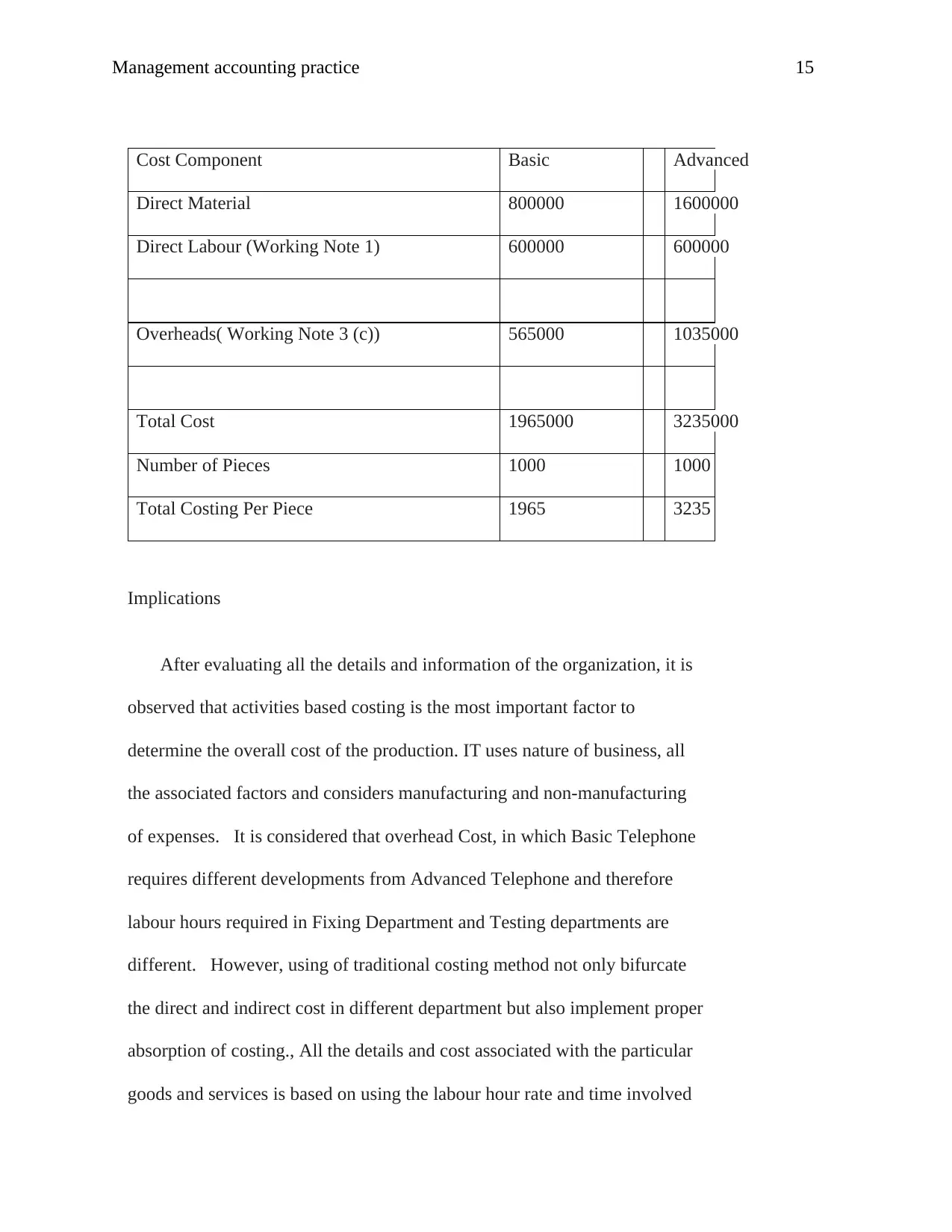
Management accounting practice 15
Cost Component Basic Advanced
Direct Material 800000 1600000
Direct Labour (Working Note 1) 600000 600000
Overheads( Working Note 3 (c)) 565000 1035000
Total Cost 1965000 3235000
Number of Pieces 1000 1000
Total Costing Per Piece 1965 3235
Implications
After evaluating all the details and information of the organization, it is
observed that activities based costing is the most important factor to
determine the overall cost of the production. IT uses nature of business, all
the associated factors and considers manufacturing and non-manufacturing
of expenses. It is considered that overhead Cost, in which Basic Telephone
requires different developments from Advanced Telephone and therefore
labour hours required in Fixing Department and Testing departments are
different. However, using of traditional costing method not only bifurcate
the direct and indirect cost in different department but also implement proper
absorption of costing., All the details and cost associated with the particular
goods and services is based on using the labour hour rate and time involved
Cost Component Basic Advanced
Direct Material 800000 1600000
Direct Labour (Working Note 1) 600000 600000
Overheads( Working Note 3 (c)) 565000 1035000
Total Cost 1965000 3235000
Number of Pieces 1000 1000
Total Costing Per Piece 1965 3235
Implications
After evaluating all the details and information of the organization, it is
observed that activities based costing is the most important factor to
determine the overall cost of the production. IT uses nature of business, all
the associated factors and considers manufacturing and non-manufacturing
of expenses. It is considered that overhead Cost, in which Basic Telephone
requires different developments from Advanced Telephone and therefore
labour hours required in Fixing Department and Testing departments are
different. However, using of traditional costing method not only bifurcate
the direct and indirect cost in different department but also implement proper
absorption of costing., All the details and cost associated with the particular
goods and services is based on using the labour hour rate and time involved
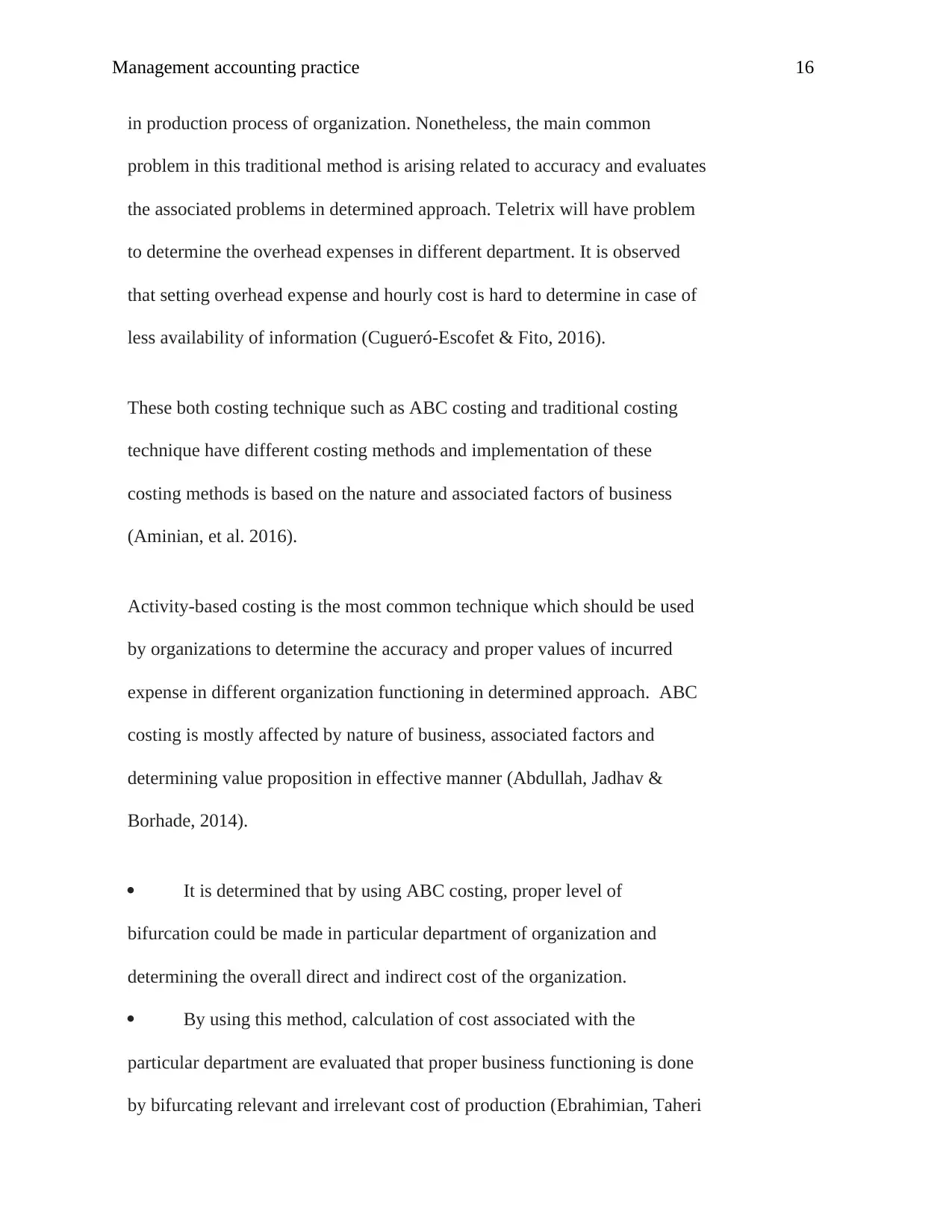
Management accounting practice 16
in production process of organization. Nonetheless, the main common
problem in this traditional method is arising related to accuracy and evaluates
the associated problems in determined approach. Teletrix will have problem
to determine the overhead expenses in different department. It is observed
that setting overhead expense and hourly cost is hard to determine in case of
less availability of information (Cugueró-Escofet & Fito, 2016).
These both costing technique such as ABC costing and traditional costing
technique have different costing methods and implementation of these
costing methods is based on the nature and associated factors of business
(Aminian, et al. 2016).
Activity-based costing is the most common technique which should be used
by organizations to determine the accuracy and proper values of incurred
expense in different organization functioning in determined approach. ABC
costing is mostly affected by nature of business, associated factors and
determining value proposition in effective manner (Abdullah, Jadhav &
Borhade, 2014).
It is determined that by using ABC costing, proper level of
bifurcation could be made in particular department of organization and
determining the overall direct and indirect cost of the organization.
By using this method, calculation of cost associated with the
particular department are evaluated that proper business functioning is done
by bifurcating relevant and irrelevant cost of production (Ebrahimian, Taheri
in production process of organization. Nonetheless, the main common
problem in this traditional method is arising related to accuracy and evaluates
the associated problems in determined approach. Teletrix will have problem
to determine the overhead expenses in different department. It is observed
that setting overhead expense and hourly cost is hard to determine in case of
less availability of information (Cugueró-Escofet & Fito, 2016).
These both costing technique such as ABC costing and traditional costing
technique have different costing methods and implementation of these
costing methods is based on the nature and associated factors of business
(Aminian, et al. 2016).
Activity-based costing is the most common technique which should be used
by organizations to determine the accuracy and proper values of incurred
expense in different organization functioning in determined approach. ABC
costing is mostly affected by nature of business, associated factors and
determining value proposition in effective manner (Abdullah, Jadhav &
Borhade, 2014).
It is determined that by using ABC costing, proper level of
bifurcation could be made in particular department of organization and
determining the overall direct and indirect cost of the organization.
By using this method, calculation of cost associated with the
particular department are evaluated that proper business functioning is done
by bifurcating relevant and irrelevant cost of production (Ebrahimian, Taheri
Secure Best Marks with AI Grader
Need help grading? Try our AI Grader for instant feedback on your assignments.
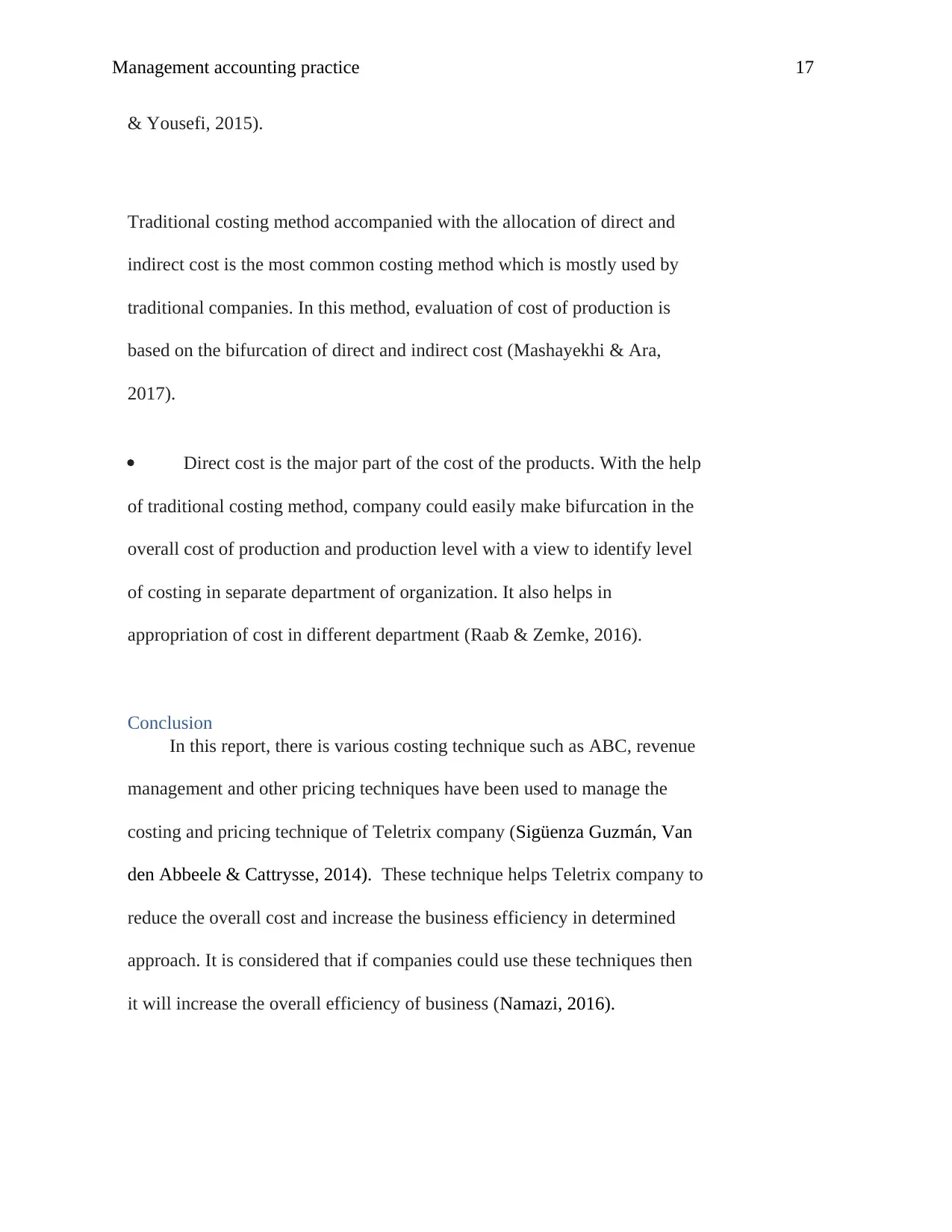
Management accounting practice 17
& Yousefi, 2015).
Traditional costing method accompanied with the allocation of direct and
indirect cost is the most common costing method which is mostly used by
traditional companies. In this method, evaluation of cost of production is
based on the bifurcation of direct and indirect cost (Mashayekhi & Ara,
2017).
Direct cost is the major part of the cost of the products. With the help
of traditional costing method, company could easily make bifurcation in the
overall cost of production and production level with a view to identify level
of costing in separate department of organization. It also helps in
appropriation of cost in different department (Raab & Zemke, 2016).
Conclusion
In this report, there is various costing technique such as ABC, revenue
management and other pricing techniques have been used to manage the
costing and pricing technique of Teletrix company (Sigüenza Guzmán, Van
den Abbeele & Cattrysse, 2014). These technique helps Teletrix company to
reduce the overall cost and increase the business efficiency in determined
approach. It is considered that if companies could use these techniques then
it will increase the overall efficiency of business (Namazi, 2016).
& Yousefi, 2015).
Traditional costing method accompanied with the allocation of direct and
indirect cost is the most common costing method which is mostly used by
traditional companies. In this method, evaluation of cost of production is
based on the bifurcation of direct and indirect cost (Mashayekhi & Ara,
2017).
Direct cost is the major part of the cost of the products. With the help
of traditional costing method, company could easily make bifurcation in the
overall cost of production and production level with a view to identify level
of costing in separate department of organization. It also helps in
appropriation of cost in different department (Raab & Zemke, 2016).
Conclusion
In this report, there is various costing technique such as ABC, revenue
management and other pricing techniques have been used to manage the
costing and pricing technique of Teletrix company (Sigüenza Guzmán, Van
den Abbeele & Cattrysse, 2014). These technique helps Teletrix company to
reduce the overall cost and increase the business efficiency in determined
approach. It is considered that if companies could use these techniques then
it will increase the overall efficiency of business (Namazi, 2016).
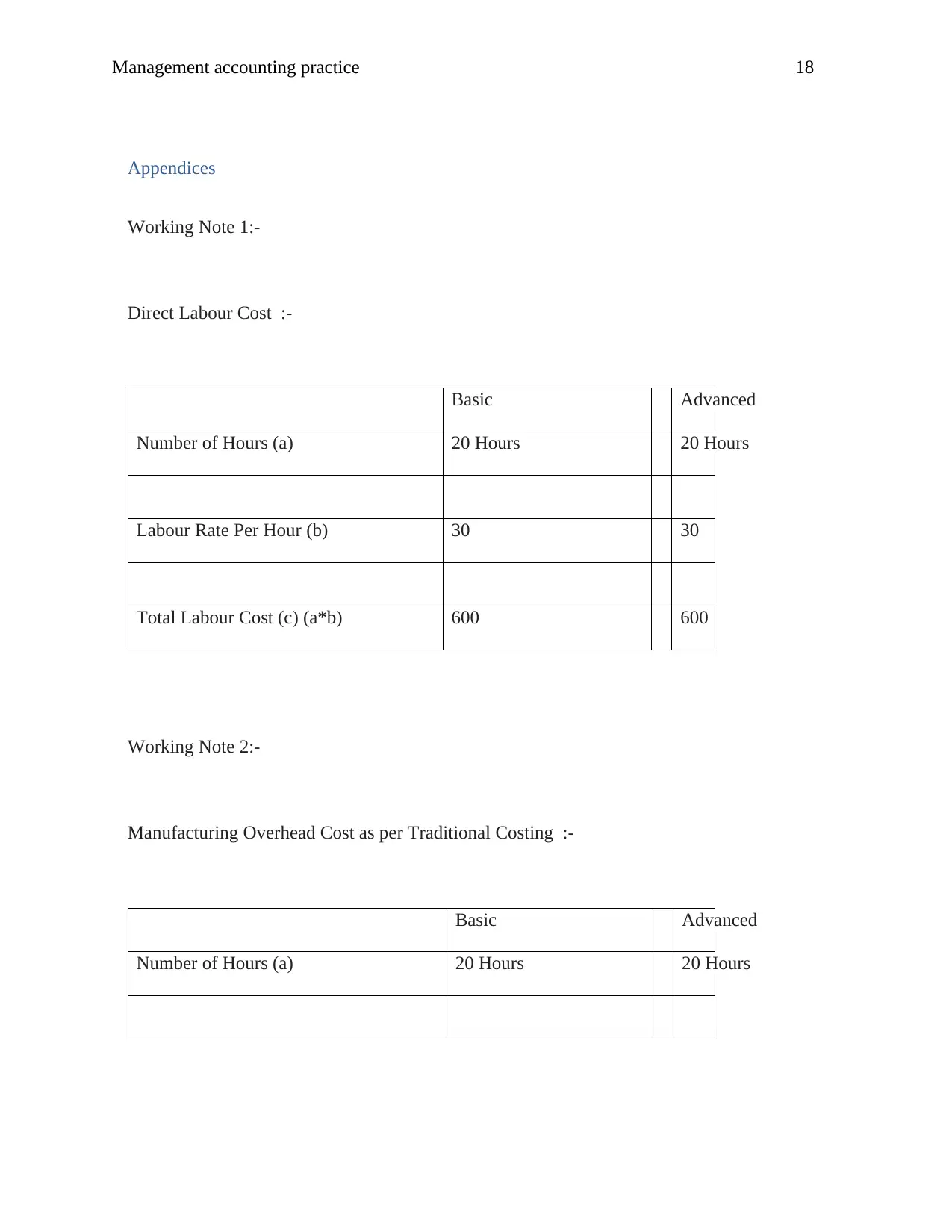
Management accounting practice 18
Appendices
Working Note 1:-
Direct Labour Cost :-
Basic Advanced
Number of Hours (a) 20 Hours 20 Hours
Labour Rate Per Hour (b) 30 30
Total Labour Cost (c) (a*b) 600 600
Working Note 2:-
Manufacturing Overhead Cost as per Traditional Costing :-
Basic Advanced
Number of Hours (a) 20 Hours 20 Hours
Appendices
Working Note 1:-
Direct Labour Cost :-
Basic Advanced
Number of Hours (a) 20 Hours 20 Hours
Labour Rate Per Hour (b) 30 30
Total Labour Cost (c) (a*b) 600 600
Working Note 2:-
Manufacturing Overhead Cost as per Traditional Costing :-
Basic Advanced
Number of Hours (a) 20 Hours 20 Hours
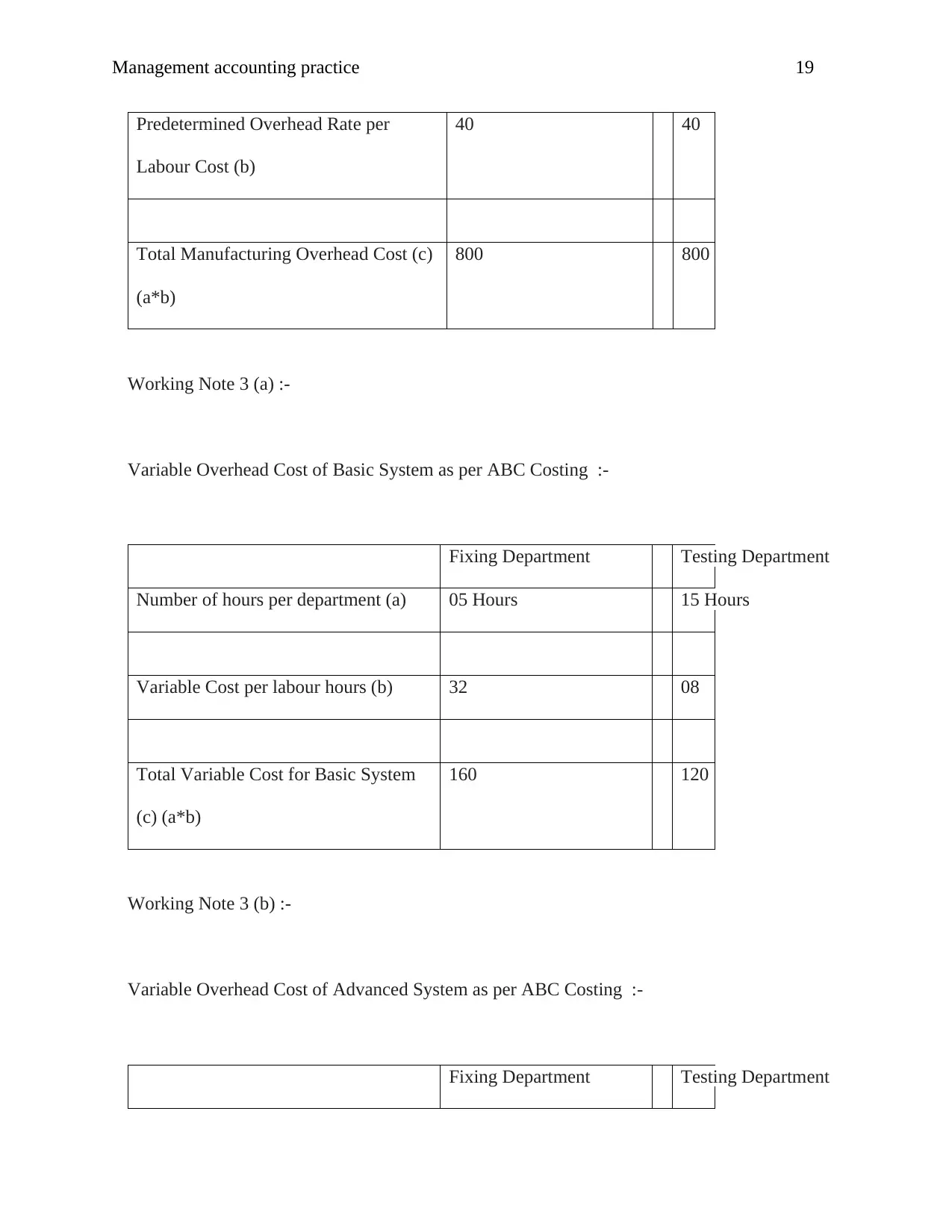
Management accounting practice 19
Predetermined Overhead Rate per
Labour Cost (b)
40 40
Total Manufacturing Overhead Cost (c)
(a*b)
800 800
Working Note 3 (a) :-
Variable Overhead Cost of Basic System as per ABC Costing :-
Fixing Department Testing Department
Number of hours per department (a) 05 Hours 15 Hours
Variable Cost per labour hours (b) 32 08
Total Variable Cost for Basic System
(c) (a*b)
160 120
Working Note 3 (b) :-
Variable Overhead Cost of Advanced System as per ABC Costing :-
Fixing Department Testing Department
Predetermined Overhead Rate per
Labour Cost (b)
40 40
Total Manufacturing Overhead Cost (c)
(a*b)
800 800
Working Note 3 (a) :-
Variable Overhead Cost of Basic System as per ABC Costing :-
Fixing Department Testing Department
Number of hours per department (a) 05 Hours 15 Hours
Variable Cost per labour hours (b) 32 08
Total Variable Cost for Basic System
(c) (a*b)
160 120
Working Note 3 (b) :-
Variable Overhead Cost of Advanced System as per ABC Costing :-
Fixing Department Testing Department
Paraphrase This Document
Need a fresh take? Get an instant paraphrase of this document with our AI Paraphraser
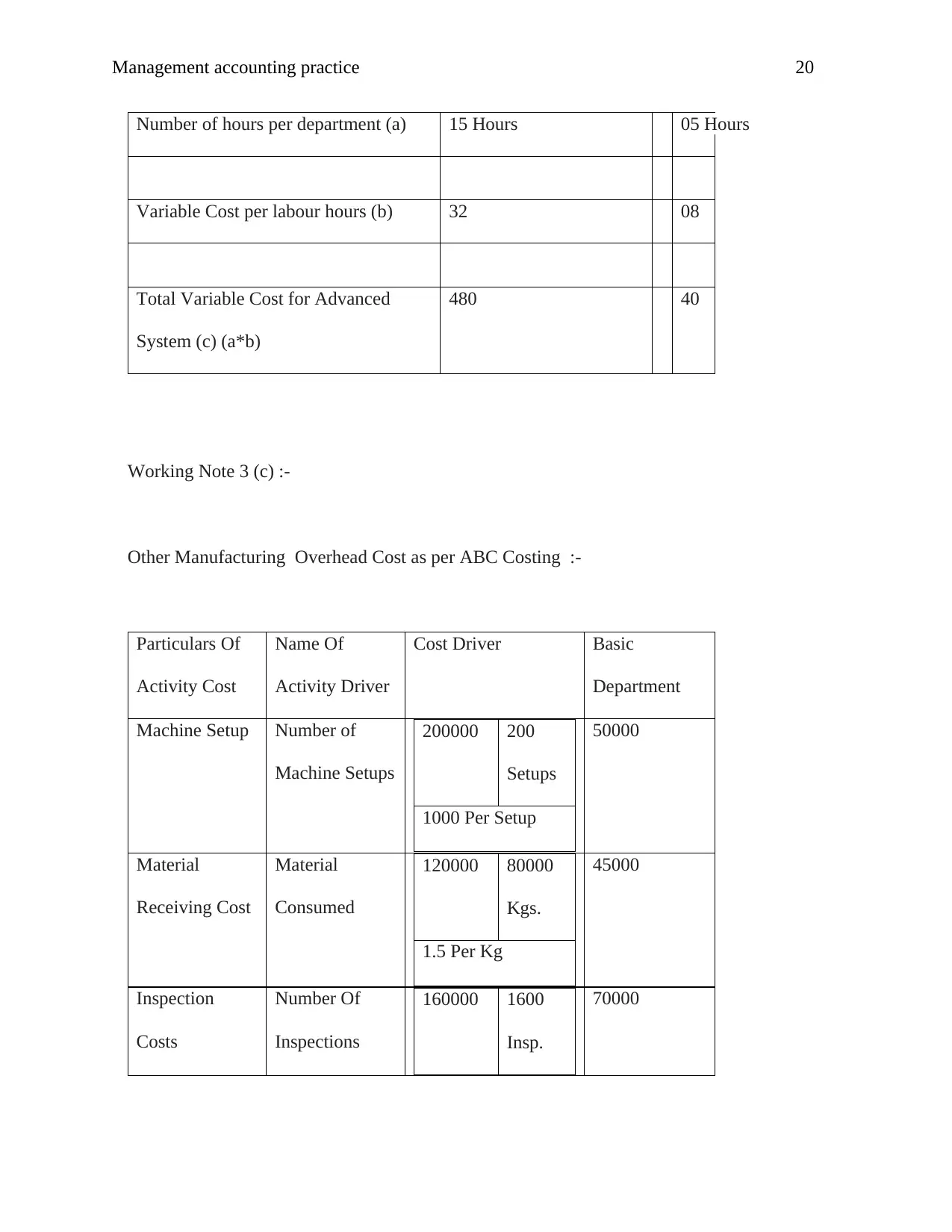
Management accounting practice 20
Number of hours per department (a) 15 Hours 05 Hours
Variable Cost per labour hours (b) 32 08
Total Variable Cost for Advanced
System (c) (a*b)
480 40
Working Note 3 (c) :-
Other Manufacturing Overhead Cost as per ABC Costing :-
Particulars Of
Activity Cost
Name Of
Activity Driver
Cost Driver Basic
Department
Machine Setup Number of
Machine Setups
200000 200
Setups
1000 Per Setup
50000
Material
Receiving Cost
Material
Consumed
120000 80000
Kgs.
1.5 Per Kg
45000
Inspection
Costs
Number Of
Inspections
160000 1600
Insp.
70000
Number of hours per department (a) 15 Hours 05 Hours
Variable Cost per labour hours (b) 32 08
Total Variable Cost for Advanced
System (c) (a*b)
480 40
Working Note 3 (c) :-
Other Manufacturing Overhead Cost as per ABC Costing :-
Particulars Of
Activity Cost
Name Of
Activity Driver
Cost Driver Basic
Department
Machine Setup Number of
Machine Setups
200000 200
Setups
1000 Per Setup
50000
Material
Receiving Cost
Material
Consumed
120000 80000
Kgs.
1.5 Per Kg
45000
Inspection
Costs
Number Of
Inspections
160000 1600
Insp.
70000
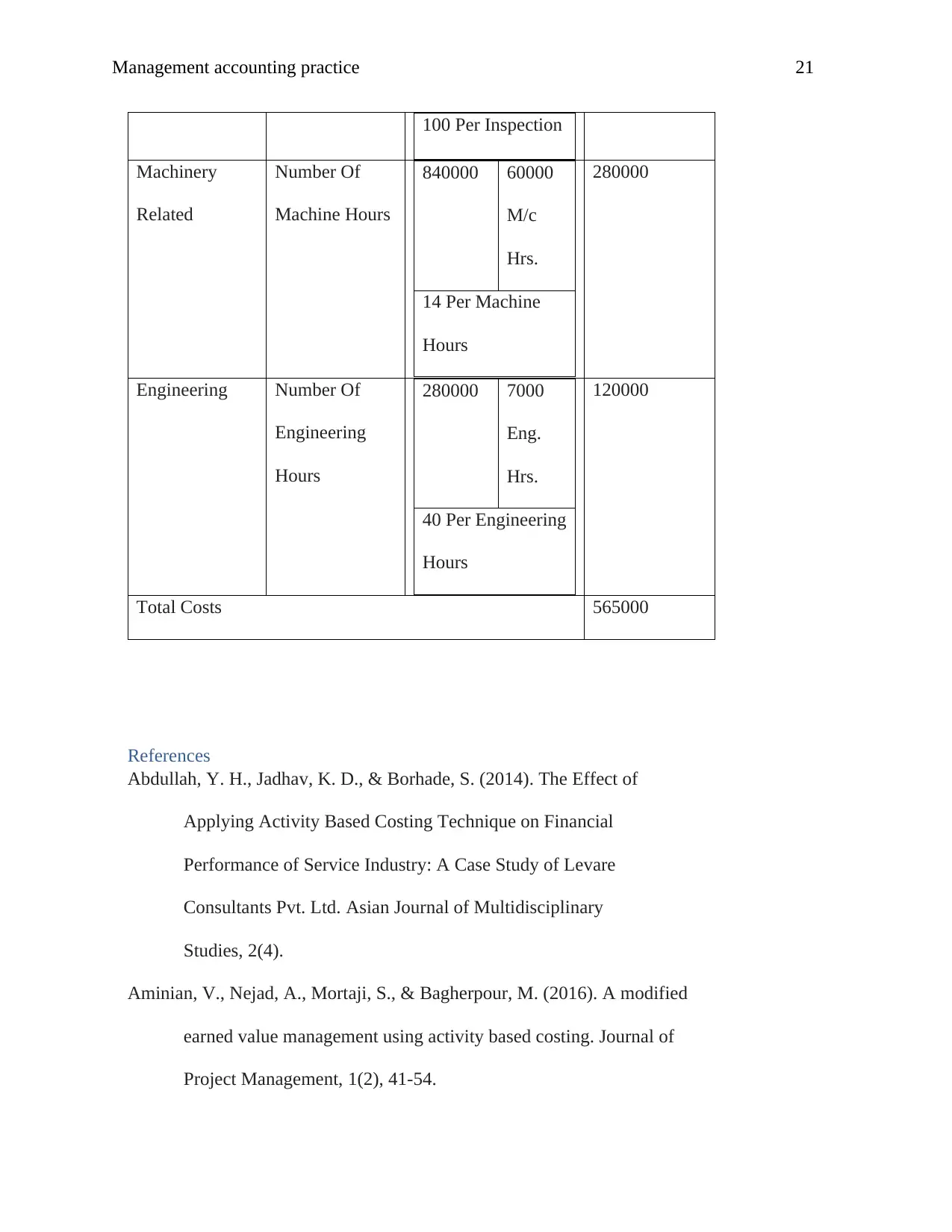
Management accounting practice 21
100 Per Inspection
Machinery
Related
Number Of
Machine Hours
840000 60000
M/c
Hrs.
14 Per Machine
Hours
280000
Engineering Number Of
Engineering
Hours
280000 7000
Eng.
Hrs.
40 Per Engineering
Hours
120000
Total Costs 565000
References
Abdullah, Y. H., Jadhav, K. D., & Borhade, S. (2014). The Effect of
Applying Activity Based Costing Technique on Financial
Performance of Service Industry: A Case Study of Levare
Consultants Pvt. Ltd. Asian Journal of Multidisciplinary
Studies, 2(4).
Aminian, V., Nejad, A., Mortaji, S., & Bagherpour, M. (2016). A modified
earned value management using activity based costing. Journal of
Project Management, 1(2), 41-54.
100 Per Inspection
Machinery
Related
Number Of
Machine Hours
840000 60000
M/c
Hrs.
14 Per Machine
Hours
280000
Engineering Number Of
Engineering
Hours
280000 7000
Eng.
Hrs.
40 Per Engineering
Hours
120000
Total Costs 565000
References
Abdullah, Y. H., Jadhav, K. D., & Borhade, S. (2014). The Effect of
Applying Activity Based Costing Technique on Financial
Performance of Service Industry: A Case Study of Levare
Consultants Pvt. Ltd. Asian Journal of Multidisciplinary
Studies, 2(4).
Aminian, V., Nejad, A., Mortaji, S., & Bagherpour, M. (2016). A modified
earned value management using activity based costing. Journal of
Project Management, 1(2), 41-54.
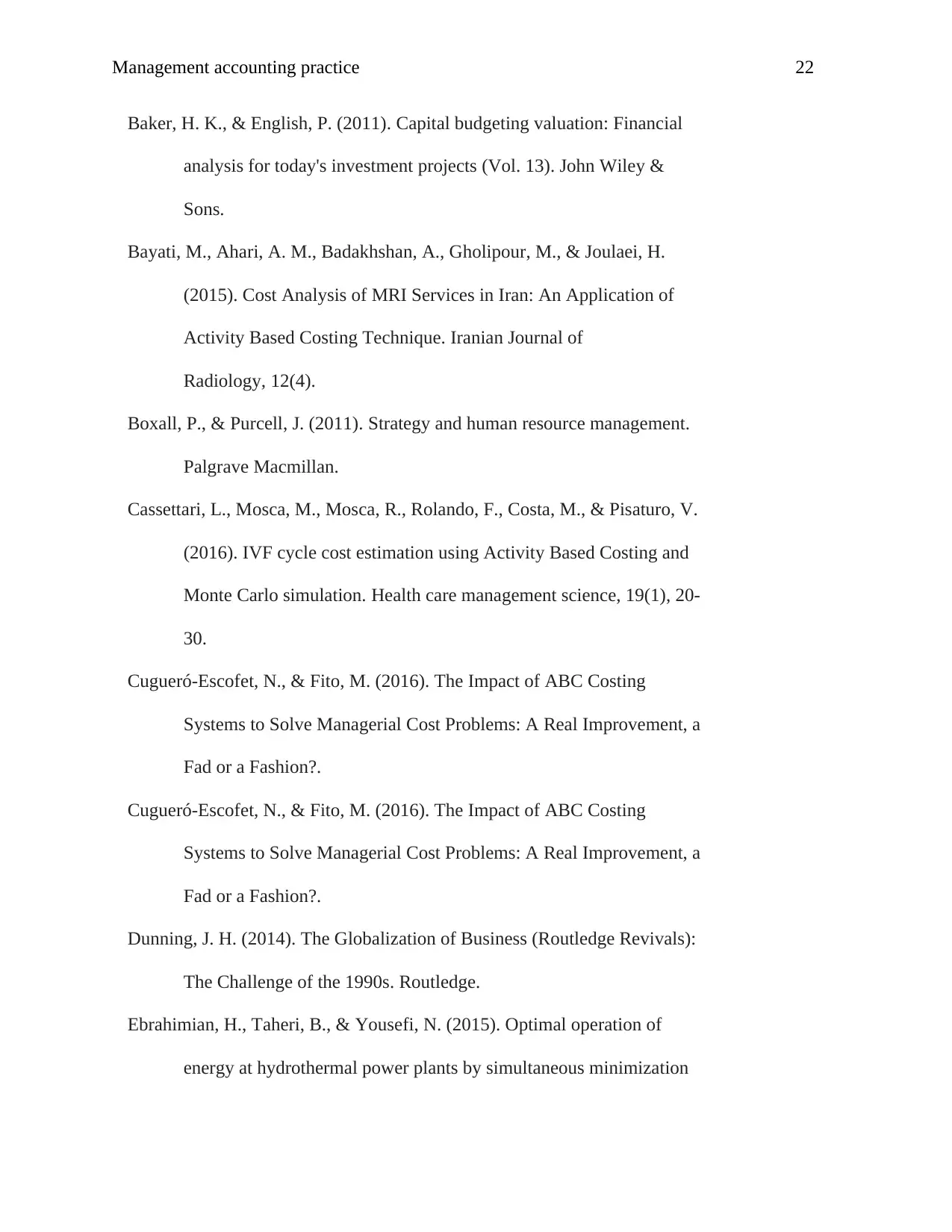
Management accounting practice 22
Baker, H. K., & English, P. (2011). Capital budgeting valuation: Financial
analysis for today's investment projects (Vol. 13). John Wiley &
Sons.
Bayati, M., Ahari, A. M., Badakhshan, A., Gholipour, M., & Joulaei, H.
(2015). Cost Analysis of MRI Services in Iran: An Application of
Activity Based Costing Technique. Iranian Journal of
Radiology, 12(4).
Boxall, P., & Purcell, J. (2011). Strategy and human resource management.
Palgrave Macmillan.
Cassettari, L., Mosca, M., Mosca, R., Rolando, F., Costa, M., & Pisaturo, V.
(2016). IVF cycle cost estimation using Activity Based Costing and
Monte Carlo simulation. Health care management science, 19(1), 20-
30.
Cugueró-Escofet, N., & Fito, M. (2016). The Impact of ABC Costing
Systems to Solve Managerial Cost Problems: A Real Improvement, a
Fad or a Fashion?.
Cugueró-Escofet, N., & Fito, M. (2016). The Impact of ABC Costing
Systems to Solve Managerial Cost Problems: A Real Improvement, a
Fad or a Fashion?.
Dunning, J. H. (2014). The Globalization of Business (Routledge Revivals):
The Challenge of the 1990s. Routledge.
Ebrahimian, H., Taheri, B., & Yousefi, N. (2015). Optimal operation of
energy at hydrothermal power plants by simultaneous minimization
Baker, H. K., & English, P. (2011). Capital budgeting valuation: Financial
analysis for today's investment projects (Vol. 13). John Wiley &
Sons.
Bayati, M., Ahari, A. M., Badakhshan, A., Gholipour, M., & Joulaei, H.
(2015). Cost Analysis of MRI Services in Iran: An Application of
Activity Based Costing Technique. Iranian Journal of
Radiology, 12(4).
Boxall, P., & Purcell, J. (2011). Strategy and human resource management.
Palgrave Macmillan.
Cassettari, L., Mosca, M., Mosca, R., Rolando, F., Costa, M., & Pisaturo, V.
(2016). IVF cycle cost estimation using Activity Based Costing and
Monte Carlo simulation. Health care management science, 19(1), 20-
30.
Cugueró-Escofet, N., & Fito, M. (2016). The Impact of ABC Costing
Systems to Solve Managerial Cost Problems: A Real Improvement, a
Fad or a Fashion?.
Cugueró-Escofet, N., & Fito, M. (2016). The Impact of ABC Costing
Systems to Solve Managerial Cost Problems: A Real Improvement, a
Fad or a Fashion?.
Dunning, J. H. (2014). The Globalization of Business (Routledge Revivals):
The Challenge of the 1990s. Routledge.
Ebrahimian, H., Taheri, B., & Yousefi, N. (2015). Optimal operation of
energy at hydrothermal power plants by simultaneous minimization
1 out of 22
Related Documents
Your All-in-One AI-Powered Toolkit for Academic Success.
+13062052269
info@desklib.com
Available 24*7 on WhatsApp / Email
![[object Object]](/_next/static/media/star-bottom.7253800d.svg)
Unlock your academic potential
© 2024 | Zucol Services PVT LTD | All rights reserved.




